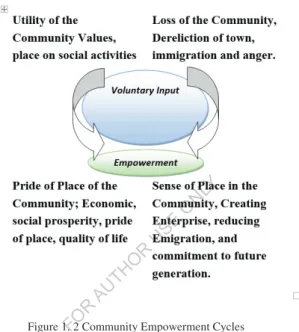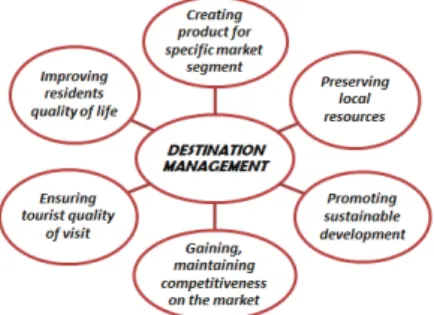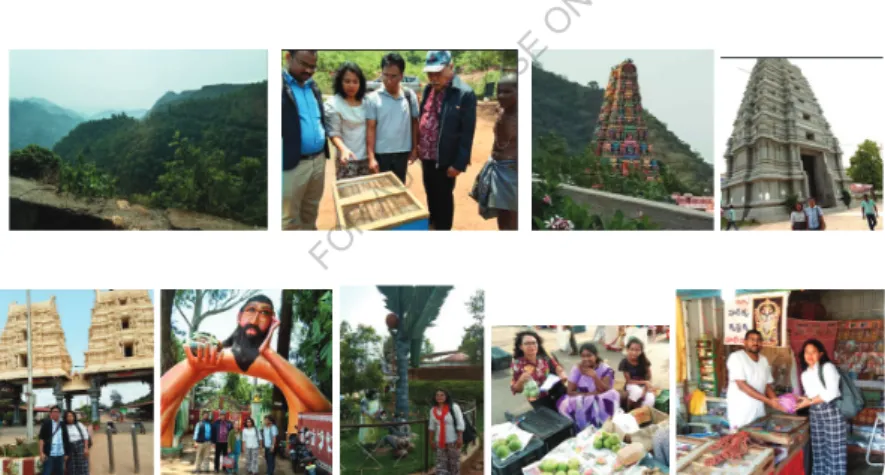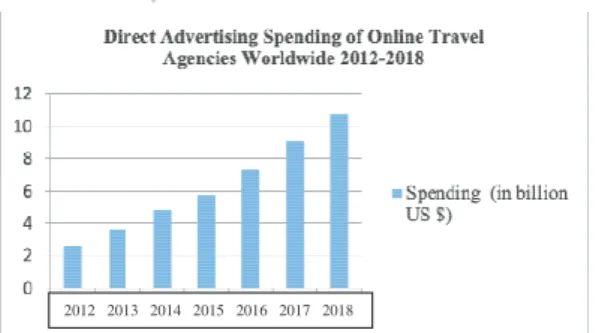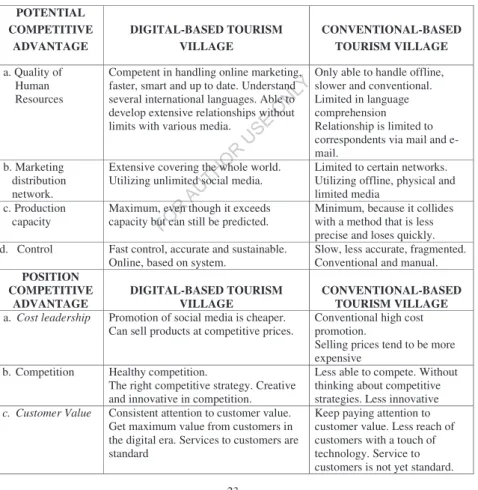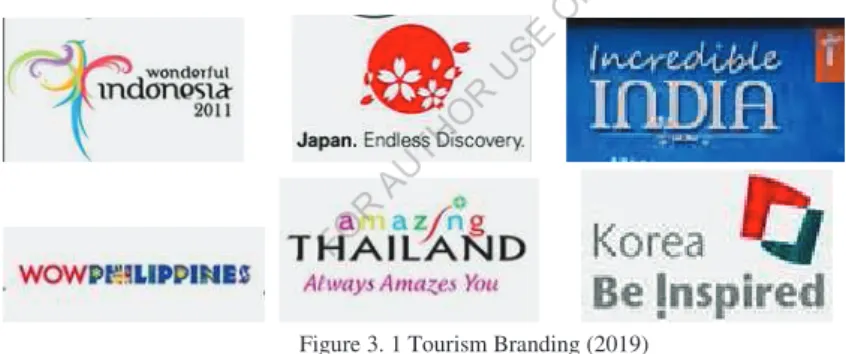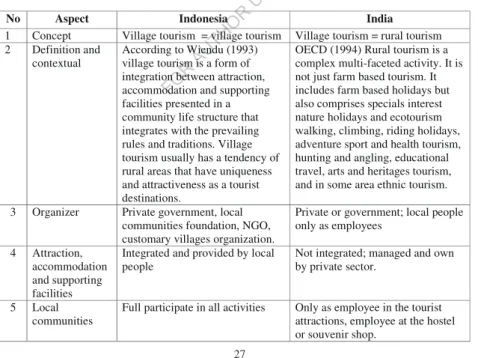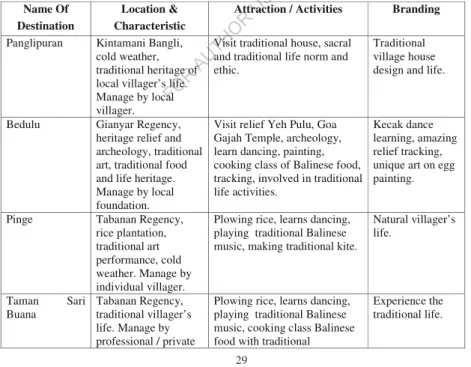! "#
$"
!"#$
%"&' ' ( ($
)*+,$#- .*/#%01
( *23) ) !%4*+)* $ !
#
5. 1&1(&1(
5 *+*6 % " & ' ' ( ($
1
d,DE'DEdEZE/E'K&s/>>'dKhZ/^D
;^ƚƌĂƚĞŐLJŝŐŝƚĂůŝnjĂƚŝŽŶ͕/ŶŶŽǀĂƚŝŽŶ͕ŽůůĂďŽƌĂƚŝŽŶdŽD^DƐĂŶĚŽŵŵƵŶŝƚLJͿ
ƵƚŚŽƌ͗
Eŝ>ƵŚWƵƚƵŐƵƐƚŝŶŝ<ĂƌƚĂ /<ĞƚƵƚ^ƵƚĂƉĂ /<ĞƚƵƚ^ŝĚĂƌƚĂ ĚŝƚŽƌ͗
/ELJŽŵĂŶ^ƵƐŝůĂ ƌ͘sŝĐƚŽƌĂďƵ<ŽƉƉƵůĂ
Preface
Writing down various learning experiences and experiences of interacting with friends and the environment, if written in a book and read by the reader, will give satisfaction to both the writer and the reader. As academics who deepen knowledge through collaborative research and community service, writing books and scientific publications is a moral responsibility that we carry and seek to develop.
The Management and Branding of Tourism Villages is an original work by the author, who has conducted research on various topics and disciplines related to the management of tourist villages in Bali, Indonesia, and in research partner countries, namely Andhra Pradesh in India. Various sub- topics that were studied from 2018 to 2022 include product innovation and digitization strategies, inclusive MSME business, and reviews of various stakeholders regarding management, branding, and sustainability indicators. The COVID-19 period was also a consideration in choosing the theme, so this research had an impact on society during the COVID-19 pandemic. Several research partners from within and outside the country were also involved, so the results of this study became richer in meaning.
Our thanks go to the Ministry of Education, Culture, Research, and Technology, which has successively provided competitive research grants through various schemes with rigors selection criteria. Thanks also to Dr. I Ketut Putra Suarthana, M.M., as Chancellor of Triatma Mulya University (UNTRIM), who fully supported this research so as to provide positive benefits to all UNTRIM academics and the world community. Thanks also to my beloved family, whose loving support and encouragement made the author's academic and research achievements even better.
In the end, there is no ivory that is not cracked. For the sake of the perfection of this book, readers' suggestions and input will be very much appreciated to help improve it.
Tabanan, 7 Juli 2023 Author,
Dr. Ni Luh Putu Agustini Karta, S.E., M.M.
3 Table of Contents
DE'DEdEZE/E'K&s/>>'dKhZ/^D͘͘͘͘͘͘͘͘͘͘͘͘͘͘͘͘͘͘͘͘͘͘͘͘͘͘͘͘͘͘͘͘͘͘͘͘͘͘͘͘͘͘͘͘͘͘͘͘͘͘͘͘͘͘͘͘͘͘͘͘͘͘͘ϭ
;^ƚƌĂƚĞŐLJŝŐŝƚĂůŝnjĂƚŝŽŶ͕/ŶŶŽǀĂƚŝŽŶ͕ŽůůĂďŽƌĂƚŝŽŶdŽD^DƐĂŶĚŽŵŵƵŶŝƚLJͿ͘͘͘͘͘͘͘͘͘͘͘͘͘͘͘͘͘͘͘͘͘͘͘͘͘͘͘͘͘͘͘͘͘͘͘ϭ ,WdZ/͘͘͘͘͘͘͘͘͘͘͘͘͘͘͘͘͘͘͘͘͘͘͘͘͘͘͘͘͘͘͘͘͘͘͘͘͘͘͘͘͘͘͘͘͘͘͘͘͘͘͘͘͘͘͘͘͘͘͘͘͘͘͘͘͘͘͘͘͘͘͘͘͘͘͘͘͘͘͘͘͘͘͘͘͘͘͘͘͘͘͘͘͘͘͘͘͘͘͘͘͘͘͘͘͘͘͘͘͘͘͘͘͘͘͘͘͘͘͘͘͘͘͘͘͘͘͘͘͘͘ϴ dŚĞDĂŶĂŐĞŵĞŶƚKĨsŝůůĂŐĞdŽƵƌŝƐŵ;ŽŵƉĂƌĂƚŝǀĞ^ƚƵĚLJŽŶsŝůůĂŐĞdŽƵƌŝƐŵŝŶĂůŝ/ŶĚŽŶĞƐŝĂĂŶĚ ŶĚŚƌĂWƌĂĚĞƐŚ/ŶĚŝĂ͘͘͘͘͘͘͘͘͘͘͘͘͘͘͘͘͘͘͘͘͘͘͘͘͘͘͘͘͘͘͘͘͘͘͘͘͘͘͘͘͘͘͘͘͘͘͘͘͘͘͘͘͘͘͘͘͘͘͘͘͘͘͘͘͘͘͘͘͘͘͘͘͘͘͘͘͘͘͘͘͘͘͘͘͘͘͘͘͘͘͘͘͘͘͘͘͘͘͘͘͘͘͘͘͘͘͘͘͘͘͘͘͘͘͘͘͘͘͘͘͘͘͘͘͘ϴ
/EdZKhd/KE͘͘͘͘͘͘͘͘͘͘͘͘͘͘͘͘͘͘͘͘͘͘͘͘͘͘͘͘͘͘͘͘͘͘͘͘͘͘͘͘͘͘͘͘͘͘͘͘͘͘͘͘͘͘͘͘͘͘͘͘͘͘͘͘͘͘͘͘͘͘͘͘͘͘͘͘͘͘͘͘͘͘͘͘͘͘͘͘͘͘͘͘͘͘͘͘͘͘͘͘͘͘͘͘͘͘͘͘͘͘͘͘͘͘͘͘͘͘͘͘͘͘͘͘͘͘͘͘͘͘͘͘͘͘͘͘͘͘͘͘͘͘͘͘͘͘͘͘͘͘͘ϴ
>/dZdhZZs/t͘͘͘͘͘͘͘͘͘͘͘͘͘͘͘͘͘͘͘͘͘͘͘͘͘͘͘͘͘͘͘͘͘͘͘͘͘͘͘͘͘͘͘͘͘͘͘͘͘͘͘͘͘͘͘͘͘͘͘͘͘͘͘͘͘͘͘͘͘͘͘͘͘͘͘͘͘͘͘͘͘͘͘͘͘͘͘͘͘͘͘͘͘͘͘͘͘͘͘͘͘͘͘͘͘͘͘͘͘͘͘͘͘͘͘͘͘͘͘͘͘͘͘͘͘͘͘͘͘͘͘͘͘͘͘͘͘͘͘͘͘͘͘ϵ ŽŵŵƵŶŝƚLJĂƐĞĚdŽƵƌŝƐŵŝŶsŝůůĂŐĞdŽƵƌŝƐŵ͘͘͘͘͘͘͘͘͘͘͘͘͘͘͘͘͘͘͘͘͘͘͘͘͘͘͘͘͘͘͘͘͘͘͘͘͘͘͘͘͘͘͘͘͘͘͘͘͘͘͘͘͘͘͘͘͘͘͘͘͘͘͘͘͘͘͘͘͘͘͘͘͘͘͘͘͘͘͘͘͘͘͘͘͘͘͘͘͘͘͘͘͘͘͘͘͘͘ϵ ŽŵŵƵŶŝƚLJŵƉŽǁĞƌŵĞŶƚ͘͘͘͘͘͘͘͘͘͘͘͘͘͘͘͘͘͘͘͘͘͘͘͘͘͘͘͘͘͘͘͘͘͘͘͘͘͘͘͘͘͘͘͘͘͘͘͘͘͘͘͘͘͘͘͘͘͘͘͘͘͘͘͘͘͘͘͘͘͘͘͘͘͘͘͘͘͘͘͘͘͘͘͘͘͘͘͘͘͘͘͘͘͘͘͘͘͘͘͘͘͘͘͘͘͘͘͘͘͘͘͘͘͘͘͘͘͘͘͘͘͘͘͘͘͘ϭϬ ĞƐƚŝŶĂƚŝŽŶDĂŶĂŐĞŵĞŶƚŝŶsŝůůĂŐĞdŽƵƌŝƐŵ͘͘͘͘͘͘͘͘͘͘͘͘͘͘͘͘͘͘͘͘͘͘͘͘͘͘͘͘͘͘͘͘͘͘͘͘͘͘͘͘͘͘͘͘͘͘͘͘͘͘͘͘͘͘͘͘͘͘͘͘͘͘͘͘͘͘͘͘͘͘͘͘͘͘͘͘͘͘͘͘͘͘͘͘͘͘͘͘͘͘͘͘͘͘͘͘͘͘͘ϭϭ Dd,KK>K'z͘͘͘͘͘͘͘͘͘͘͘͘͘͘͘͘͘͘͘͘͘͘͘͘͘͘͘͘͘͘͘͘͘͘͘͘͘͘͘͘͘͘͘͘͘͘͘͘͘͘͘͘͘͘͘͘͘͘͘͘͘͘͘͘͘͘͘͘͘͘͘͘͘͘͘͘͘͘͘͘͘͘͘͘͘͘͘͘͘͘͘͘͘͘͘͘͘͘͘͘͘͘͘͘͘͘͘͘͘͘͘͘͘͘͘͘͘͘͘͘͘͘͘͘͘͘͘͘͘͘͘͘͘͘͘͘͘͘͘͘͘͘͘͘͘͘͘͘͘ϭϮ /^h^^/KEEE>z^/^͘͘͘͘͘͘͘͘͘͘͘͘͘͘͘͘͘͘͘͘͘͘͘͘͘͘͘͘͘͘͘͘͘͘͘͘͘͘͘͘͘͘͘͘͘͘͘͘͘͘͘͘͘͘͘͘͘͘͘͘͘͘͘͘͘͘͘͘͘͘͘͘͘͘͘͘͘͘͘͘͘͘͘͘͘͘͘͘͘͘͘͘͘͘͘͘͘͘͘͘͘͘͘͘͘͘͘͘͘͘͘͘͘͘͘͘͘͘͘͘͘͘͘͘͘͘͘͘͘͘͘ϭϯ sŝůůĂŐĞdŽƵƌŝƐŵŝŶ/ŶĚŽŶĞƐŝĂ͘͘͘͘͘͘͘͘͘͘͘͘͘͘͘͘͘͘͘͘͘͘͘͘͘͘͘͘͘͘͘͘͘͘͘͘͘͘͘͘͘͘͘͘͘͘͘͘͘͘͘͘͘͘͘͘͘͘͘͘͘͘͘͘͘͘͘͘͘͘͘͘͘͘͘͘͘͘͘͘͘͘͘͘͘͘͘͘͘͘͘͘͘͘͘͘͘͘͘͘͘͘͘͘͘͘͘͘͘͘͘͘͘͘͘͘͘͘͘͘͘͘͘͘ϭϯ sŝůůĂŐĞdŽƵƌŝƐŵŝŶ/ŶĚŝĂ͘͘͘͘͘͘͘͘͘͘͘͘͘͘͘͘͘͘͘͘͘͘͘͘͘͘͘͘͘͘͘͘͘͘͘͘͘͘͘͘͘͘͘͘͘͘͘͘͘͘͘͘͘͘͘͘͘͘͘͘͘͘͘͘͘͘͘͘͘͘͘͘͘͘͘͘͘͘͘͘͘͘͘͘͘͘͘͘͘͘͘͘͘͘͘͘͘͘͘͘͘͘͘͘͘͘͘͘͘͘͘͘͘͘͘͘͘͘͘͘͘͘͘͘͘͘͘͘͘͘͘͘ϭϰ KE>h^/KE͘͘͘͘͘͘͘͘͘͘͘͘͘͘͘͘͘͘͘͘͘͘͘͘͘͘͘͘͘͘͘͘͘͘͘͘͘͘͘͘͘͘͘͘͘͘͘͘͘͘͘͘͘͘͘͘͘͘͘͘͘͘͘͘͘͘͘͘͘͘͘͘͘͘͘͘͘͘͘͘͘͘͘͘͘͘͘͘͘͘͘͘͘͘͘͘͘͘͘͘͘͘͘͘͘͘͘͘͘͘͘͘͘͘͘͘͘͘͘͘͘͘͘͘͘͘͘͘͘͘͘͘͘͘͘͘͘͘͘͘͘͘͘͘͘͘͘͘͘͘͘͘͘ϭϲ ,WdZ//͘͘͘͘͘͘͘͘͘͘͘͘͘͘͘͘͘͘͘͘͘͘͘͘͘͘͘͘͘͘͘͘͘͘͘͘͘͘͘͘͘͘͘͘͘͘͘͘͘͘͘͘͘͘͘͘͘͘͘͘͘͘͘͘͘͘͘͘͘͘͘͘͘͘͘͘͘͘͘͘͘͘͘͘͘͘͘͘͘͘͘͘͘͘͘͘͘͘͘͘͘͘͘͘͘͘͘͘͘͘͘͘͘͘͘͘͘͘͘͘͘͘͘͘͘͘͘ϭϳ ŝŐŝƚĂůDĂƌŬĞƚŝŶŐ/ŶĐƌĞĂƐĞŽŵƉĞƚŝƚŝǀĞĚǀĂŶƚĂŐĞ͘͘͘͘͘͘͘͘͘͘͘͘͘͘͘͘͘͘͘͘͘͘͘͘͘͘͘͘͘͘͘͘͘͘͘͘͘͘͘͘͘͘͘͘͘͘͘͘͘͘͘͘͘͘͘͘͘͘͘͘͘͘͘͘͘͘͘͘͘͘͘͘͘͘͘͘͘ϭϳ sŝůůĂŐĞdŽƵƌŝƐŵŝŶĂůŝ/ŶĚŽŶĞƐŝĂ͘͘͘͘͘͘͘͘͘͘͘͘͘͘͘͘͘͘͘͘͘͘͘͘͘͘͘͘͘͘͘͘͘͘͘͘͘͘͘͘͘͘͘͘͘͘͘͘͘͘͘͘͘͘͘͘͘͘͘͘͘͘͘͘͘͘͘͘͘͘͘͘͘͘͘͘͘͘͘͘͘͘͘͘͘͘͘͘͘͘͘͘͘͘͘͘͘͘͘͘͘͘͘͘͘ϭϳ /EdZKhd/KE͘͘͘͘͘͘͘͘͘͘͘͘͘͘͘͘͘͘͘͘͘͘͘͘͘͘͘͘͘͘͘͘͘͘͘͘͘͘͘͘͘͘͘͘͘͘͘͘͘͘͘͘͘͘͘͘͘͘͘͘͘͘͘͘͘͘͘͘͘͘͘͘͘͘͘͘͘͘͘͘͘͘͘͘͘͘͘͘͘͘͘͘͘͘͘͘͘͘͘͘͘͘͘͘͘͘͘͘͘͘͘͘͘͘͘͘͘͘͘͘͘͘͘͘͘͘͘͘͘͘͘͘͘͘͘͘͘͘͘͘͘͘͘͘͘͘͘͘͘ϭϳ d,KZ/d/>Zs/t͘͘͘͘͘͘͘͘͘͘͘͘͘͘͘͘͘͘͘͘͘͘͘͘͘͘͘͘͘͘͘͘͘͘͘͘͘͘͘͘͘͘͘͘͘͘͘͘͘͘͘͘͘͘͘͘͘͘͘͘͘͘͘͘͘͘͘͘͘͘͘͘͘͘͘͘͘͘͘͘͘͘͘͘͘͘͘͘͘͘͘͘͘͘͘͘͘͘͘͘͘͘͘͘͘͘͘͘͘͘͘͘͘͘͘͘͘͘͘͘͘͘͘͘͘͘͘͘͘͘͘͘͘͘͘͘͘͘͘͘ϭϴ dŚĞ^ŚŝĨƚŝŶŐŽĨDĂƌŬĞƚŝŶŐ͘͘͘͘͘͘͘͘͘͘͘͘͘͘͘͘͘͘͘͘͘͘͘͘͘͘͘͘͘͘͘͘͘͘͘͘͘͘͘͘͘͘͘͘͘͘͘͘͘͘͘͘͘͘͘͘͘͘͘͘͘͘͘͘͘͘͘͘͘͘͘͘͘͘͘͘͘͘͘͘͘͘͘͘͘͘͘͘͘͘͘͘͘͘͘͘͘͘͘͘͘͘͘͘͘͘͘͘͘͘͘͘͘͘͘͘͘͘͘͘͘͘͘͘͘͘͘͘ϭϴ ŝŐŝƚĂůDĂƌŬĞƚŝŶŐŝŶ>ĂƌŐĞĂŶĚ^ŵĂůůƵƐŝŶĞƐƐ͘͘͘͘͘͘͘͘͘͘͘͘͘͘͘͘͘͘͘͘͘͘͘͘͘͘͘͘͘͘͘͘͘͘͘͘͘͘͘͘͘͘͘͘͘͘͘͘͘͘͘͘͘͘͘͘͘͘͘͘͘͘͘͘͘͘͘͘͘͘͘͘͘͘͘͘͘͘͘͘͘͘͘͘͘͘͘͘͘͘͘͘͘͘͘͘͘ϭϵ ŝŐŝƚĂůDĂƌŬĞƚŝŶŐĂŶĚŽŵƉĞƚŝƚŝǀĞĚǀĂŶƚĂŐĞ͘͘͘͘͘͘͘͘͘͘͘͘͘͘͘͘͘͘͘͘͘͘͘͘͘͘͘͘͘͘͘͘͘͘͘͘͘͘͘͘͘͘͘͘͘͘͘͘͘͘͘͘͘͘͘͘͘͘͘͘͘͘͘͘͘͘͘͘͘͘͘͘͘͘͘͘͘͘͘͘͘͘͘͘͘͘͘͘͘͘͘͘͘͘͘͘ϭϵ Dd,KK>K'z͘͘͘͘͘͘͘͘͘͘͘͘͘͘͘͘͘͘͘͘͘͘͘͘͘͘͘͘͘͘͘͘͘͘͘͘͘͘͘͘͘͘͘͘͘͘͘͘͘͘͘͘͘͘͘͘͘͘͘͘͘͘͘͘͘͘͘͘͘͘͘͘͘͘͘͘͘͘͘͘͘͘͘͘͘͘͘͘͘͘͘͘͘͘͘͘͘͘͘͘͘͘͘͘͘͘͘͘͘͘͘͘͘͘͘͘͘͘͘͘͘͘͘͘͘͘͘͘͘͘͘͘͘͘͘͘͘͘͘͘͘͘͘͘͘͘͘͘͘ϮϬ /^h^^/KE͘͘͘͘͘͘͘͘͘͘͘͘͘͘͘͘͘͘͘͘͘͘͘͘͘͘͘͘͘͘͘͘͘͘͘͘͘͘͘͘͘͘͘͘͘͘͘͘͘͘͘͘͘͘͘͘͘͘͘͘͘͘͘͘͘͘͘͘͘͘͘͘͘͘͘͘͘͘͘͘͘͘͘͘͘͘͘͘͘͘͘͘͘͘͘͘͘͘͘͘͘͘͘͘͘͘͘͘͘͘͘͘͘͘͘͘͘͘͘͘͘͘͘͘͘͘͘͘͘͘͘͘͘͘͘͘͘͘͘͘͘͘͘͘͘͘͘͘͘͘͘͘͘͘͘ϮϬ ŝŐŝƚĂůDĂƌŬĞƚŝŶŐĐƚŝǀŝƚŝĞƐŽĨdŽƵƌŝƐŵsŝůůĂŐĞƐŝŶĂůŝ͘͘͘͘͘͘͘͘͘͘͘͘͘͘͘͘͘͘͘͘͘͘͘͘͘͘͘͘͘͘͘͘͘͘͘͘͘͘͘͘͘͘͘͘͘͘͘͘͘͘͘͘͘͘͘͘͘͘͘͘͘͘͘͘͘͘͘͘͘͘͘͘͘͘͘͘͘͘͘͘͘͘͘͘ϮϬ WŝŶŐĞdŽƵƌŝƐŵsŝůůĂŐĞ͘͘͘͘͘͘͘͘͘͘͘͘͘͘͘͘͘͘͘͘͘͘͘͘͘͘͘͘͘͘͘͘͘͘͘͘͘͘͘͘͘͘͘͘͘͘͘͘͘͘͘͘͘͘͘͘͘͘͘͘͘͘͘͘͘͘͘͘͘͘͘͘͘͘͘͘͘͘͘͘͘͘͘͘͘͘͘͘͘͘͘͘͘͘͘͘͘͘͘͘͘͘͘͘͘͘͘͘͘͘͘͘͘͘͘͘͘͘͘͘͘͘͘͘͘͘͘͘͘͘͘͘͘͘͘Ϯϭ ĞĚƵůƵdŽƵƌŝƐŵsŝůůĂŐĞ͘͘͘͘͘͘͘͘͘͘͘͘͘͘͘͘͘͘͘͘͘͘͘͘͘͘͘͘͘͘͘͘͘͘͘͘͘͘͘͘͘͘͘͘͘͘͘͘͘͘͘͘͘͘͘͘͘͘͘͘͘͘͘͘͘͘͘͘͘͘͘͘͘͘͘͘͘͘͘͘͘͘͘͘͘͘͘͘͘͘͘͘͘͘͘͘͘͘͘͘͘͘͘͘͘͘͘͘͘͘͘͘͘͘͘͘͘͘͘͘͘͘͘͘͘͘͘͘͘͘͘͘Ϯϭ dĂŵĂŶ^ĂƌŝƵĂŶĂdŽƵƌŝƐŵsŝůůĂŐĞ͘͘͘͘͘͘͘͘͘͘͘͘͘͘͘͘͘͘͘͘͘͘͘͘͘͘͘͘͘͘͘͘͘͘͘͘͘͘͘͘͘͘͘͘͘͘͘͘͘͘͘͘͘͘͘͘͘͘͘͘͘͘͘͘͘͘͘͘͘͘͘͘͘͘͘͘͘͘͘͘͘͘͘͘͘͘͘͘͘͘͘͘͘͘͘͘͘͘͘͘͘͘͘͘͘͘͘͘͘͘͘͘͘͘͘ϮϮ WĞŶŐůŝƉƵƌĂŶdŽƵƌŝƐŵsŝůůĂŐĞ͘͘͘͘͘͘͘͘͘͘͘͘͘͘͘͘͘͘͘͘͘͘͘͘͘͘͘͘͘͘͘͘͘͘͘͘͘͘͘͘͘͘͘͘͘͘͘͘͘͘͘͘͘͘͘͘͘͘͘͘͘͘͘͘͘͘͘͘͘͘͘͘͘͘͘͘͘͘͘͘͘͘͘͘͘͘͘͘͘͘͘͘͘͘͘͘͘͘͘͘͘͘͘͘͘͘͘͘͘͘͘͘͘͘͘͘͘͘͘͘͘͘͘͘ϮϮ ůŝŵďŝŶŐ^ĂƌŝdŽƵƌŝƐŵsŝůůĂŐĞ͘͘͘͘͘͘͘͘͘͘͘͘͘͘͘͘͘͘͘͘͘͘͘͘͘͘͘͘͘͘͘͘͘͘͘͘͘͘͘͘͘͘͘͘͘͘͘͘͘͘͘͘͘͘͘͘͘͘͘͘͘͘͘͘͘͘͘͘͘͘͘͘͘͘͘͘͘͘͘͘͘͘͘͘͘͘͘͘͘͘͘͘͘͘͘͘͘͘͘͘͘͘͘͘͘͘͘͘͘͘͘͘͘͘͘͘͘͘͘͘͘͘͘ϮϮ ŽŵƉĂƌŝƐŽŶĂŶĚŶĂůLJƐŝƐŽĨŽŵƉĞƚŝƚŝǀĞĚǀĂŶƚĂŐĞƐĂƐĞĚŝŐŝƚĂůdŽƵƌŝƐŵsŝůůĂŐĞ͘͘͘͘͘͘͘͘͘͘͘͘͘͘͘͘͘͘͘͘͘͘͘͘͘͘͘Ϯϯ KE>h^/KE^E^h''^d/KE^͘͘͘͘͘͘͘͘͘͘͘͘͘͘͘͘͘͘͘͘͘͘͘͘͘͘͘͘͘͘͘͘͘͘͘͘͘͘͘͘͘͘͘͘͘͘͘͘͘͘͘͘͘͘͘͘͘͘͘͘͘͘͘͘͘͘͘͘͘͘͘͘͘͘͘͘͘͘͘͘͘͘͘͘͘͘͘͘͘͘͘͘͘͘͘͘͘͘͘͘͘͘͘͘͘͘͘͘͘͘͘͘͘͘͘͘͘͘͘Ϯϰ ,WdZ///͘͘͘͘͘͘͘͘͘͘͘͘͘͘͘͘͘͘͘͘͘͘͘͘͘͘͘͘͘͘͘͘͘͘͘͘͘͘͘͘͘͘͘͘͘͘͘͘͘͘͘͘͘͘͘͘͘͘͘͘͘͘͘͘͘͘͘͘͘͘͘͘͘͘͘͘͘͘͘͘͘͘͘͘͘͘͘͘͘͘͘͘͘͘͘͘͘͘͘͘͘͘͘͘͘͘͘͘͘͘͘͘͘͘͘͘͘͘͘͘͘͘͘͘͘͘Ϯϱ dŚĞZŽůĞƐĂŶĚŽŶƚƌŝďƵƚŝŽŶƐŽĨ^ƚĂŬĞŚŽůĚĞƌƐŝŶsŝůůĂŐĞƐdŽƵƌŝƐŵƌĂŶĚDĂŶĂŐĞŵĞŶƚŝŶĂůŝĂŶĚ/ŶĚŝĂ
͘͘͘͘͘͘͘͘͘͘͘͘͘͘͘͘͘͘͘͘͘͘͘͘͘͘͘͘͘͘͘͘͘͘͘͘͘͘͘͘͘͘͘͘͘͘͘͘͘͘͘͘͘͘͘͘͘͘͘͘͘͘͘͘͘͘͘͘͘͘͘͘͘͘͘͘͘͘͘͘͘͘͘͘͘͘͘͘͘͘͘͘͘͘͘͘͘͘͘͘͘͘͘͘͘͘͘͘͘͘͘͘͘͘͘͘͘͘͘͘͘͘͘͘͘͘͘͘͘͘͘͘͘͘͘͘͘͘͘͘͘͘͘͘͘͘͘͘͘͘͘͘͘͘͘͘͘Ϯϱ /EdZKhd/KE͘͘͘͘͘͘͘͘͘͘͘͘͘͘͘͘͘͘͘͘͘͘͘͘͘͘͘͘͘͘͘͘͘͘͘͘͘͘͘͘͘͘͘͘͘͘͘͘͘͘͘͘͘͘͘͘͘͘͘͘͘͘͘͘͘͘͘͘͘͘͘͘͘͘͘͘͘͘͘͘͘͘͘͘͘͘͘͘͘͘͘͘͘͘͘͘͘͘͘͘͘͘͘͘͘͘͘͘͘͘͘͘͘͘͘͘͘͘͘͘͘͘͘͘͘͘͘͘͘͘͘͘͘͘͘͘͘͘͘͘͘͘͘͘͘͘͘͘͘Ϯϱ
>/dZdhZZs/t͘͘͘͘͘͘͘͘͘͘͘͘͘͘͘͘͘͘͘͘͘͘͘͘͘͘͘͘͘͘͘͘͘͘͘͘͘͘͘͘͘͘͘͘͘͘͘͘͘͘͘͘͘͘͘͘͘͘͘͘͘͘͘͘͘͘͘͘͘͘͘͘͘͘͘͘͘͘͘͘͘͘͘͘͘͘͘͘͘͘͘͘͘͘͘͘͘͘͘͘͘͘͘͘͘͘͘͘͘͘͘͘͘͘͘͘͘͘͘͘͘͘͘͘͘͘͘͘͘͘͘͘͘͘͘͘͘͘͘͘͘͘Ϯϲ Dd,KK>K'z͘͘͘͘͘͘͘͘͘͘͘͘͘͘͘͘͘͘͘͘͘͘͘͘͘͘͘͘͘͘͘͘͘͘͘͘͘͘͘͘͘͘͘͘͘͘͘͘͘͘͘͘͘͘͘͘͘͘͘͘͘͘͘͘͘͘͘͘͘͘͘͘͘͘͘͘͘͘͘͘͘͘͘͘͘͘͘͘͘͘͘͘͘͘͘͘͘͘͘͘͘͘͘͘͘͘͘͘͘͘͘͘͘͘͘͘͘͘͘͘͘͘͘͘͘͘͘͘͘͘͘͘͘͘͘͘͘͘͘͘͘͘͘͘͘͘͘͘͘Ϯϴ Z^h>dE/^h^^/KE͘͘͘͘͘͘͘͘͘͘͘͘͘͘͘͘͘͘͘͘͘͘͘͘͘͘͘͘͘͘͘͘͘͘͘͘͘͘͘͘͘͘͘͘͘͘͘͘͘͘͘͘͘͘͘͘͘͘͘͘͘͘͘͘͘͘͘͘͘͘͘͘͘͘͘͘͘͘͘͘͘͘͘͘͘͘͘͘͘͘͘͘͘͘͘͘͘͘͘͘͘͘͘͘͘͘͘͘͘͘͘͘͘͘͘͘͘͘͘͘͘͘͘͘͘͘͘͘͘͘͘͘͘͘Ϯϵ WƌŽĨŝůĞŽĨsŝůůĂŐĞƚŽƵƌŝƐŵƐŝŶĂůŝ/ŶĚŽŶĞƐŝĂĂŶĚŶĚŚƌĂWƌĂĚĞƐŚ/ŶĚŝĂ͘͘͘͘͘͘͘͘͘͘͘͘͘͘͘͘͘͘͘͘͘͘͘͘͘͘͘͘͘͘͘͘͘͘͘͘͘͘͘͘͘͘͘͘͘͘͘͘͘͘͘͘͘͘͘͘͘͘Ϯϵ ůĞŵĞŶƚƐŽĨƌĂŶĚŝŶŐsŝůůĂŐĞdŽƵƌŝƐŵƐŝŶĂůŝ/ŶĚŽŶĞƐŝĂĂŶĚŶĚŚƌĂWƌĂĚĞƐŚ/ŶĚŝĂ͘͘͘͘͘͘͘͘͘͘͘͘͘͘͘͘͘͘͘͘͘͘͘͘͘͘͘ϯϬ sŝůůĂŐĞƚŽƵƌŝƐŵĚĞƐƚŝŶĂƚŝŽŶŝŶĂůŝ/ŶĚŽŶĞƐŝĂ͘͘͘͘͘͘͘͘͘͘͘͘͘͘͘͘͘͘͘͘͘͘͘͘͘͘͘͘͘͘͘͘͘͘͘͘͘͘͘͘͘͘͘͘͘͘͘͘͘͘͘͘͘͘͘͘͘͘͘͘͘͘͘͘͘͘͘͘͘͘͘͘͘͘͘͘͘͘͘͘͘͘͘͘͘͘͘ϯϬ
ƌĂŶĚĂƐWƌŽĚƵĐƚ͘͘͘͘͘͘͘͘͘͘͘͘͘͘͘͘͘͘͘͘͘͘͘͘͘͘͘͘͘͘͘͘͘͘͘͘͘͘͘͘͘͘͘͘͘͘͘͘͘͘͘͘͘͘͘͘͘͘͘͘͘͘͘͘͘͘͘͘͘͘͘͘͘͘͘͘͘͘͘͘͘͘͘͘͘͘͘͘͘͘͘͘͘͘͘͘͘͘͘͘͘͘͘͘͘͘͘͘͘͘͘͘͘͘͘͘͘͘͘͘͘͘͘͘͘͘͘͘͘͘͘͘͘͘͘͘͘͘͘͘͘͘ϯϭ ƌĂŶĚĂƐ^LJŵďŽů͘͘͘͘͘͘͘͘͘͘͘͘͘͘͘͘͘͘͘͘͘͘͘͘͘͘͘͘͘͘͘͘͘͘͘͘͘͘͘͘͘͘͘͘͘͘͘͘͘͘͘͘͘͘͘͘͘͘͘͘͘͘͘͘͘͘͘͘͘͘͘͘͘͘͘͘͘͘͘͘͘͘͘͘͘͘͘͘͘͘͘͘͘͘͘͘͘͘͘͘͘͘͘͘͘͘͘͘͘͘͘͘͘͘͘͘͘͘͘͘͘͘͘͘͘͘͘͘͘͘͘͘͘͘͘͘͘͘͘͘͘͘͘ϯϭ ƌĂŶĚĂƐWĞƌƐŽŶ͘͘͘͘͘͘͘͘͘͘͘͘͘͘͘͘͘͘͘͘͘͘͘͘͘͘͘͘͘͘͘͘͘͘͘͘͘͘͘͘͘͘͘͘͘͘͘͘͘͘͘͘͘͘͘͘͘͘͘͘͘͘͘͘͘͘͘͘͘͘͘͘͘͘͘͘͘͘͘͘͘͘͘͘͘͘͘͘͘͘͘͘͘͘͘͘͘͘͘͘͘͘͘͘͘͘͘͘͘͘͘͘͘͘͘͘͘͘͘͘͘͘͘͘͘͘͘͘͘͘͘͘͘͘͘͘͘͘͘͘͘͘͘ϯϭ sŝůůĂŐĞdŽƵƌŝƐŵĞƐƚŝŶĂƚŝŽŶŝŶŶĚŚƌĂWƌĂĚĞƐŚ/ŶĚŝĂ͘͘͘͘͘͘͘͘͘͘͘͘͘͘͘͘͘͘͘͘͘͘͘͘͘͘͘͘͘͘͘͘͘͘͘͘͘͘͘͘͘͘͘͘͘͘͘͘͘͘͘͘͘͘͘͘͘͘͘͘͘͘͘͘͘͘͘͘͘͘͘͘͘͘ϯϮ ƌĂŶĚĂƐĂ^LJŵďŽů͘͘͘͘͘͘͘͘͘͘͘͘͘͘͘͘͘͘͘͘͘͘͘͘͘͘͘͘͘͘͘͘͘͘͘͘͘͘͘͘͘͘͘͘͘͘͘͘͘͘͘͘͘͘͘͘͘͘͘͘͘͘͘͘͘͘͘͘͘͘͘͘͘͘͘͘͘͘͘͘͘͘͘͘͘͘͘͘͘͘͘͘͘͘͘͘͘͘͘͘͘͘͘͘͘͘͘͘͘͘͘͘͘͘͘͘͘͘͘͘͘͘͘͘͘͘͘͘͘͘͘͘͘͘͘͘͘͘͘͘ϯϮ ƌĂŶĚĂƐĂWƌŽĚƵĐƚ͘͘͘͘͘͘͘͘͘͘͘͘͘͘͘͘͘͘͘͘͘͘͘͘͘͘͘͘͘͘͘͘͘͘͘͘͘͘͘͘͘͘͘͘͘͘͘͘͘͘͘͘͘͘͘͘͘͘͘͘͘͘͘͘͘͘͘͘͘͘͘͘͘͘͘͘͘͘͘͘͘͘͘͘͘͘͘͘͘͘͘͘͘͘͘͘͘͘͘͘͘͘͘͘͘͘͘͘͘͘͘͘͘͘͘͘͘͘͘͘͘͘͘͘͘͘͘͘͘͘͘͘͘͘͘͘͘͘͘ϯϯ ƌĂŶĚĂƐĂWĞƌƐŽŶ͘͘͘͘͘͘͘͘͘͘͘͘͘͘͘͘͘͘͘͘͘͘͘͘͘͘͘͘͘͘͘͘͘͘͘͘͘͘͘͘͘͘͘͘͘͘͘͘͘͘͘͘͘͘͘͘͘͘͘͘͘͘͘͘͘͘͘͘͘͘͘͘͘͘͘͘͘͘͘͘͘͘͘͘͘͘͘͘͘͘͘͘͘͘͘͘͘͘͘͘͘͘͘͘͘͘͘͘͘͘͘͘͘͘͘͘͘͘͘͘͘͘͘͘͘͘͘͘͘͘͘͘͘͘͘͘͘͘͘͘ϯϯ
^ƚĂŬĞŚŽůĚĞƌŽŶƚƌŝďƵƚŝŽŶƐŝŶƌĂŶĚŝŶŐsŝůůĂŐĞƐdŽƵƌŝƐŵŝŶĂůŝĂŶĚŶĚŚƌĂWƌĂĚĞƐŚ͘͘͘͘͘͘͘͘͘͘͘͘͘͘͘͘͘͘͘͘͘͘͘͘͘͘ϯϰ
^ƚĂŬĞŚŽůĚĞƌŽŶƚƌŝďƵƚŝŽŶŝŶďƌĂŶĚŝŶŐǀŝůůĂŐĞƚŽƵƌŝƐŵƐŝŶĂůŝ͘͘͘͘͘͘͘͘͘͘͘͘͘͘͘͘͘͘͘͘͘͘͘͘͘͘͘͘͘͘͘͘͘͘͘͘͘͘͘͘͘͘͘͘͘͘͘͘͘͘͘͘͘͘͘͘͘͘͘͘͘ϯϰ
^ƚĂŬĞŚŽůĚĞƌĐŽŶƚƌŝďƵƚŝŽŶƐŝŶďƌĂŶĚŝŶŐǀŝůůĂŐĞƚŽƵƌŝƐŵŝŶŶĚŚƌĂWƌĂĚĞƐŚ/ŶĚŝĂ͘͘͘͘͘͘͘͘͘͘͘͘͘͘͘͘͘͘͘͘͘͘͘͘͘͘͘͘͘͘͘͘͘ϯϱ dŚĞŵŽĚĞůŽĨƐƚĂŬĞŚŽůĚĞƌĐŽŶƚƌŝďƵƚŝŽŶŝŶǀŝůůĂŐĞƚŽƵƌŝƐŵ͘͘͘͘͘͘͘͘͘͘͘͘͘͘͘͘͘͘͘͘͘͘͘͘͘͘͘͘͘͘͘͘͘͘͘͘͘͘͘͘͘͘͘͘͘͘͘͘͘͘͘͘͘͘͘͘͘͘͘͘͘͘͘͘͘͘͘ϯϱ KE>h^/KE͘͘͘͘͘͘͘͘͘͘͘͘͘͘͘͘͘͘͘͘͘͘͘͘͘͘͘͘͘͘͘͘͘͘͘͘͘͘͘͘͘͘͘͘͘͘͘͘͘͘͘͘͘͘͘͘͘͘͘͘͘͘͘͘͘͘͘͘͘͘͘͘͘͘͘͘͘͘͘͘͘͘͘͘͘͘͘͘͘͘͘͘͘͘͘͘͘͘͘͘͘͘͘͘͘͘͘͘͘͘͘͘͘͘͘͘͘͘͘͘͘͘͘͘͘͘͘͘͘͘͘͘͘͘͘͘͘͘͘͘͘͘͘͘͘͘͘͘͘͘͘͘͘ϯϲ ,WdZ/s͘͘͘͘͘͘͘͘͘͘͘͘͘͘͘͘͘͘͘͘͘͘͘͘͘͘͘͘͘͘͘͘͘͘͘͘͘͘͘͘͘͘͘͘͘͘͘͘͘͘͘͘͘͘͘͘͘͘͘͘͘͘͘͘͘͘͘͘͘͘͘͘͘͘͘͘͘͘͘͘͘͘͘͘͘͘͘͘͘͘͘͘͘͘͘͘͘͘͘͘͘͘͘͘͘͘͘͘͘͘͘͘͘͘͘͘͘͘͘͘͘͘͘͘͘͘ϯϳ ,ŽǁŽĞƐƚŚĞƌĂŶĚŝŶŐ^ƚƌĂƚĞŐLJŽĨƚŚĞsŝůůĂŐĞdŽƵƌŝƐŵ/ŵƉĂĐƚŝŶ^ƚƌĞŶŐƚŚĞŶŝŶŐƚŚĞ/ŵĂŐĞŝŶĂůŝ͍͘͘ϯϳ /EdZKhd/KE͘͘͘͘͘͘͘͘͘͘͘͘͘͘͘͘͘͘͘͘͘͘͘͘͘͘͘͘͘͘͘͘͘͘͘͘͘͘͘͘͘͘͘͘͘͘͘͘͘͘͘͘͘͘͘͘͘͘͘͘͘͘͘͘͘͘͘͘͘͘͘͘͘͘͘͘͘͘͘͘͘͘͘͘͘͘͘͘͘͘͘͘͘͘͘͘͘͘͘͘͘͘͘͘͘͘͘͘͘͘͘͘͘͘͘͘͘͘͘͘͘͘͘͘͘͘͘͘͘͘͘͘͘͘͘͘͘͘͘͘͘͘͘͘͘͘͘͘͘ϯϳ
>/dZdhZZs/t͘͘͘͘͘͘͘͘͘͘͘͘͘͘͘͘͘͘͘͘͘͘͘͘͘͘͘͘͘͘͘͘͘͘͘͘͘͘͘͘͘͘͘͘͘͘͘͘͘͘͘͘͘͘͘͘͘͘͘͘͘͘͘͘͘͘͘͘͘͘͘͘͘͘͘͘͘͘͘͘͘͘͘͘͘͘͘͘͘͘͘͘͘͘͘͘͘͘͘͘͘͘͘͘͘͘͘͘͘͘͘͘͘͘͘͘͘͘͘͘͘͘͘͘͘͘͘͘͘͘͘͘͘͘͘͘͘͘͘͘͘͘ϯϴ Dd,KK>K'z͘͘͘͘͘͘͘͘͘͘͘͘͘͘͘͘͘͘͘͘͘͘͘͘͘͘͘͘͘͘͘͘͘͘͘͘͘͘͘͘͘͘͘͘͘͘͘͘͘͘͘͘͘͘͘͘͘͘͘͘͘͘͘͘͘͘͘͘͘͘͘͘͘͘͘͘͘͘͘͘͘͘͘͘͘͘͘͘͘͘͘͘͘͘͘͘͘͘͘͘͘͘͘͘͘͘͘͘͘͘͘͘͘͘͘͘͘͘͘͘͘͘͘͘͘͘͘͘͘͘͘͘͘͘͘͘͘͘͘͘͘͘͘͘͘͘͘͘͘ϰϬ Z^h>dE/^h^^/KE͘͘͘͘͘͘͘͘͘͘͘͘͘͘͘͘͘͘͘͘͘͘͘͘͘͘͘͘͘͘͘͘͘͘͘͘͘͘͘͘͘͘͘͘͘͘͘͘͘͘͘͘͘͘͘͘͘͘͘͘͘͘͘͘͘͘͘͘͘͘͘͘͘͘͘͘͘͘͘͘͘͘͘͘͘͘͘͘͘͘͘͘͘͘͘͘͘͘͘͘͘͘͘͘͘͘͘͘͘͘͘͘͘͘͘͘͘͘͘͘͘͘͘͘͘͘͘͘͘͘͘͘͘͘ϰϭ WƌŽĨŝůĞŽĨdŽƵƌŝƐƚƐsŝůůĂŐĞƐ^ƚƵĚŝĞĚŝŶƌŝĞĨ͘͘͘͘͘͘͘͘͘͘͘͘͘͘͘͘͘͘͘͘͘͘͘͘͘͘͘͘͘͘͘͘͘͘͘͘͘͘͘͘͘͘͘͘͘͘͘͘͘͘͘͘͘͘͘͘͘͘͘͘͘͘͘͘͘͘͘͘͘͘͘͘͘͘͘͘͘͘͘͘͘͘͘͘͘͘͘͘͘͘͘͘͘͘͘͘͘͘͘͘͘͘ϰϭ ƌĂŶĚŝŶŐdŽƵƌŝƐŵsŝůůĂŐĞ/ŶĂůŝ͘͘͘͘͘͘͘͘͘͘͘͘͘͘͘͘͘͘͘͘͘͘͘͘͘͘͘͘͘͘͘͘͘͘͘͘͘͘͘͘͘͘͘͘͘͘͘͘͘͘͘͘͘͘͘͘͘͘͘͘͘͘͘͘͘͘͘͘͘͘͘͘͘͘͘͘͘͘͘͘͘͘͘͘͘͘͘͘͘͘͘͘͘͘͘͘͘͘͘͘͘͘͘͘͘͘͘͘͘͘͘͘͘͘͘͘͘͘ϰϭ dŚĞ/ŶĨůƵĞŶĐĞŽĨƌĂŶĚƋƵŝƚLJŝŶ^ƚƌĞŶŐƚŚĞŶŝŶŐƚŚĞ/ŵĂŐĞ͘͘͘͘͘͘͘͘͘͘͘͘͘͘͘͘͘͘͘͘͘͘͘͘͘͘͘͘͘͘͘͘͘͘͘͘͘͘͘͘͘͘͘͘͘͘͘͘͘͘͘͘͘͘͘͘͘͘͘͘͘͘͘͘͘͘͘͘͘͘͘͘͘͘͘͘͘ϰϯ KE>h^/KE^͘͘͘͘͘͘͘͘͘͘͘͘͘͘͘͘͘͘͘͘͘͘͘͘͘͘͘͘͘͘͘͘͘͘͘͘͘͘͘͘͘͘͘͘͘͘͘͘͘͘͘͘͘͘͘͘͘͘͘͘͘͘͘͘͘͘͘͘͘͘͘͘͘͘͘͘͘͘͘͘͘͘͘͘͘͘͘͘͘͘͘͘͘͘͘͘͘͘͘͘͘͘͘͘͘͘͘͘͘͘͘͘͘͘͘͘͘͘͘͘͘͘͘͘͘͘͘͘͘͘͘͘͘͘͘͘͘͘͘͘͘͘͘͘͘͘͘͘͘͘͘ϰϲ ,WdZs͘͘͘͘͘͘͘͘͘͘͘͘͘͘͘͘͘͘͘͘͘͘͘͘͘͘͘͘͘͘͘͘͘͘͘͘͘͘͘͘͘͘͘͘͘͘͘͘͘͘͘͘͘͘͘͘͘͘͘͘͘͘͘͘͘͘͘͘͘͘͘͘͘͘͘͘͘͘͘͘͘͘͘͘͘͘͘͘͘͘͘͘͘͘͘͘͘͘͘͘͘͘͘͘͘͘͘͘͘͘͘͘͘͘͘͘͘͘͘͘͘͘͘͘͘͘͘ϰϴ ƵƐŝŶĞƐƐ/ŶĐůƵƐŝǀĞ^LJŶĞƌŐLJ^ƚƌĂƚĞŐLJǁŝƚŚD^DƐ^ƵƉƉŽƌƚƐdŽƵƌŝƐŵsŝůůĂŐĞƐŝŶĞƉĂŬĂsŝůůĂŐĞ͕dĂďĂŶĂŶ ZĞŐĞŶĐLJ͘͘͘͘͘͘͘͘͘͘͘͘͘͘͘͘͘͘͘͘͘͘͘͘͘͘͘͘͘͘͘͘͘͘͘͘͘͘͘͘͘͘͘͘͘͘͘͘͘͘͘͘͘͘͘͘͘͘͘͘͘͘͘͘͘͘͘͘͘͘͘͘͘͘͘͘͘͘͘͘͘͘͘͘͘͘͘͘͘͘͘͘͘͘͘͘͘͘͘͘͘͘͘͘͘͘͘͘͘͘͘͘͘͘͘͘͘͘͘͘͘͘͘͘͘͘͘͘͘͘͘͘͘͘͘͘͘͘͘͘͘͘͘͘ϰϴ /EdZKhd/KE͘͘͘͘͘͘͘͘͘͘͘͘͘͘͘͘͘͘͘͘͘͘͘͘͘͘͘͘͘͘͘͘͘͘͘͘͘͘͘͘͘͘͘͘͘͘͘͘͘͘͘͘͘͘͘͘͘͘͘͘͘͘͘͘͘͘͘͘͘͘͘͘͘͘͘͘͘͘͘͘͘͘͘͘͘͘͘͘͘͘͘͘͘͘͘͘͘͘͘͘͘͘͘͘͘͘͘͘͘͘͘͘͘͘͘͘͘͘͘͘͘͘͘͘͘͘͘͘͘͘͘͘͘͘͘͘͘͘͘͘͘͘͘͘͘͘͘͘͘ϰϴ
>/dZdhZZs/t͘͘͘͘͘͘͘͘͘͘͘͘͘͘͘͘͘͘͘͘͘͘͘͘͘͘͘͘͘͘͘͘͘͘͘͘͘͘͘͘͘͘͘͘͘͘͘͘͘͘͘͘͘͘͘͘͘͘͘͘͘͘͘͘͘͘͘͘͘͘͘͘͘͘͘͘͘͘͘͘͘͘͘͘͘͘͘͘͘͘͘͘͘͘͘͘͘͘͘͘͘͘͘͘͘͘͘͘͘͘͘͘͘͘͘͘͘͘͘͘͘͘͘͘͘͘͘͘͘͘͘͘͘͘͘͘͘͘͘͘͘͘ϰϴ Dd,KK>K'z͘͘͘͘͘͘͘͘͘͘͘͘͘͘͘͘͘͘͘͘͘͘͘͘͘͘͘͘͘͘͘͘͘͘͘͘͘͘͘͘͘͘͘͘͘͘͘͘͘͘͘͘͘͘͘͘͘͘͘͘͘͘͘͘͘͘͘͘͘͘͘͘͘͘͘͘͘͘͘͘͘͘͘͘͘͘͘͘͘͘͘͘͘͘͘͘͘͘͘͘͘͘͘͘͘͘͘͘͘͘͘͘͘͘͘͘͘͘͘͘͘͘͘͘͘͘͘͘͘͘͘͘͘͘͘͘͘͘͘͘͘͘͘͘͘͘͘͘͘ϱϬ /^h^^/KE͘͘͘͘͘͘͘͘͘͘͘͘͘͘͘͘͘͘͘͘͘͘͘͘͘͘͘͘͘͘͘͘͘͘͘͘͘͘͘͘͘͘͘͘͘͘͘͘͘͘͘͘͘͘͘͘͘͘͘͘͘͘͘͘͘͘͘͘͘͘͘͘͘͘͘͘͘͘͘͘͘͘͘͘͘͘͘͘͘͘͘͘͘͘͘͘͘͘͘͘͘͘͘͘͘͘͘͘͘͘͘͘͘͘͘͘͘͘͘͘͘͘͘͘͘͘͘͘͘͘͘͘͘͘͘͘͘͘͘͘͘͘͘͘͘͘͘͘͘͘͘͘͘͘͘ϱϬ KǀĞƌǀŝĞǁŽĨD^DƐŝŶĞƉĂŬĂsŝůůĂŐĞ͘͘͘͘͘͘͘͘͘͘͘͘͘͘͘͘͘͘͘͘͘͘͘͘͘͘͘͘͘͘͘͘͘͘͘͘͘͘͘͘͘͘͘͘͘͘͘͘͘͘͘͘͘͘͘͘͘͘͘͘͘͘͘͘͘͘͘͘͘͘͘͘͘͘͘͘͘͘͘͘͘͘͘͘͘͘͘͘͘͘͘͘͘͘͘͘͘͘͘͘͘͘͘͘͘͘͘͘͘ϱϬ D^DZĞƐŝůŝĞŶĐĞ^ƚƌĂƚĞŐLJŝŶĞƉĂŬĂsŝůůĂŐĞ͘͘͘͘͘͘͘͘͘͘͘͘͘͘͘͘͘͘͘͘͘͘͘͘͘͘͘͘͘͘͘͘͘͘͘͘͘͘͘͘͘͘͘͘͘͘͘͘͘͘͘͘͘͘͘͘͘͘͘͘͘͘͘͘͘͘͘͘͘͘͘͘͘͘͘͘͘͘͘͘͘͘͘͘͘͘͘͘͘͘͘͘͘͘͘͘͘͘͘ϱϭ ƵƐŝŶĞƐƐ/ŶĐůƵƐŝŽŶŝŶĞƉĂŬĂsŝůůĂŐĞ͘͘͘͘͘͘͘͘͘͘͘͘͘͘͘͘͘͘͘͘͘͘͘͘͘͘͘͘͘͘͘͘͘͘͘͘͘͘͘͘͘͘͘͘͘͘͘͘͘͘͘͘͘͘͘͘͘͘͘͘͘͘͘͘͘͘͘͘͘͘͘͘͘͘͘͘͘͘͘͘͘͘͘͘͘͘͘͘͘͘͘͘͘͘͘͘͘͘͘͘͘͘͘͘͘͘͘͘͘͘͘͘ϱϮ KE>h^/KE͘͘͘͘͘͘͘͘͘͘͘͘͘͘͘͘͘͘͘͘͘͘͘͘͘͘͘͘͘͘͘͘͘͘͘͘͘͘͘͘͘͘͘͘͘͘͘͘͘͘͘͘͘͘͘͘͘͘͘͘͘͘͘͘͘͘͘͘͘͘͘͘͘͘͘͘͘͘͘͘͘͘͘͘͘͘͘͘͘͘͘͘͘͘͘͘͘͘͘͘͘͘͘͘͘͘͘͘͘͘͘͘͘͘͘͘͘͘͘͘͘͘͘͘͘͘͘͘͘͘͘͘͘͘͘͘͘͘͘͘͘͘͘͘͘͘͘͘͘͘͘͘͘ϱϯ ,WdZs/͘͘͘͘͘͘͘͘͘͘͘͘͘͘͘͘͘͘͘͘͘͘͘͘͘͘͘͘͘͘͘͘͘͘͘͘͘͘͘͘͘͘͘͘͘͘͘͘͘͘͘͘͘͘͘͘͘͘͘͘͘͘͘͘͘͘͘͘͘͘͘͘͘͘͘͘͘͘͘͘͘͘͘͘͘͘͘͘͘͘͘͘͘͘͘͘͘͘͘͘͘͘͘͘͘͘͘͘͘͘͘͘͘͘͘͘͘͘͘͘͘͘͘͘͘͘ϱϱ
ŽŵŵƵŶŝƚLJ/ŶǀŽůǀĞŵĞŶƚ/ŶWĂĐŬĂŐŝŶŐ/ŶŶŽǀĂƚŝŽŶŶƐƵƌŝŶŐdŚĞ^ƵƐƚĂŝŶĂďŝůŝƚLJKĨĞƐƚŝŶĂƚŝŽŶ;ĂƐĞ
^ƚƵĚLJ/ŶsŝůůĂŐĞdŽƵƌŝƐŵĞƉĂŬĂŶĚWĞƚĂŬƵƌŝŶŐŽǀŝĚͲϭϵͿ͘͘͘͘͘͘͘͘͘͘͘͘͘͘͘͘͘͘͘͘͘͘͘͘͘͘͘͘͘͘͘͘͘͘͘͘͘͘͘͘͘͘͘͘͘͘͘͘͘͘͘͘͘͘͘͘͘͘͘͘͘͘ϱϱ /EdZKhd/KE͘͘͘͘͘͘͘͘͘͘͘͘͘͘͘͘͘͘͘͘͘͘͘͘͘͘͘͘͘͘͘͘͘͘͘͘͘͘͘͘͘͘͘͘͘͘͘͘͘͘͘͘͘͘͘͘͘͘͘͘͘͘͘͘͘͘͘͘͘͘͘͘͘͘͘͘͘͘͘͘͘͘͘͘͘͘͘͘͘͘͘͘͘͘͘͘͘͘͘͘͘͘͘͘͘͘͘͘͘͘͘͘͘͘͘͘͘͘͘͘͘͘͘͘͘͘͘͘͘͘͘͘͘͘͘͘͘͘͘͘͘͘͘͘͘͘͘͘͘ϱϱ ĞƉĂŬĂsŝůůĂŐĞ͘͘͘͘͘͘͘͘͘͘͘͘͘͘͘͘͘͘͘͘͘͘͘͘͘͘͘͘͘͘͘͘͘͘͘͘͘͘͘͘͘͘͘͘͘͘͘͘͘͘͘͘͘͘͘͘͘͘͘͘͘͘͘͘͘͘͘͘͘͘͘͘͘͘͘͘͘͘͘͘͘͘͘͘͘͘͘͘͘͘͘͘͘͘͘͘͘͘͘͘͘͘͘͘͘͘͘͘͘͘͘͘͘͘͘͘͘͘͘͘͘͘͘͘͘͘͘͘͘͘͘͘͘͘͘͘͘͘͘͘͘͘͘͘͘͘ϱϱ WĞƚĂŬsŝůůĂŐĞ͘͘͘͘͘͘͘͘͘͘͘͘͘͘͘͘͘͘͘͘͘͘͘͘͘͘͘͘͘͘͘͘͘͘͘͘͘͘͘͘͘͘͘͘͘͘͘͘͘͘͘͘͘͘͘͘͘͘͘͘͘͘͘͘͘͘͘͘͘͘͘͘͘͘͘͘͘͘͘͘͘͘͘͘͘͘͘͘͘͘͘͘͘͘͘͘͘͘͘͘͘͘͘͘͘͘͘͘͘͘͘͘͘͘͘͘͘͘͘͘͘͘͘͘͘͘͘͘͘͘͘͘͘͘͘͘͘͘͘͘͘͘͘͘͘͘͘͘͘ϱϲ
>/dZdhZZs/t͘͘͘͘͘͘͘͘͘͘͘͘͘͘͘͘͘͘͘͘͘͘͘͘͘͘͘͘͘͘͘͘͘͘͘͘͘͘͘͘͘͘͘͘͘͘͘͘͘͘͘͘͘͘͘͘͘͘͘͘͘͘͘͘͘͘͘͘͘͘͘͘͘͘͘͘͘͘͘͘͘͘͘͘͘͘͘͘͘͘͘͘͘͘͘͘͘͘͘͘͘͘͘͘͘͘͘͘͘͘͘͘͘͘͘͘͘͘͘͘͘͘͘͘͘͘͘͘͘͘͘͘͘͘͘͘͘͘͘͘͘͘ϱϴ ŽŵŵƵŶŝƚLJ/ŶǀŽůǀĞŵĞŶƚŝŶdŽƵƌŝƐŵWĂĐŬĂŐŝŶŐ͘͘͘͘͘͘͘͘͘͘͘͘͘͘͘͘͘͘͘͘͘͘͘͘͘͘͘͘͘͘͘͘͘͘͘͘͘͘͘͘͘͘͘͘͘͘͘͘͘͘͘͘͘͘͘͘͘͘͘͘͘͘͘͘͘͘͘͘͘͘͘͘͘͘͘͘͘͘͘͘͘͘͘͘͘͘͘͘͘͘͘͘͘͘͘ϱϴ dŽƵƌŝƐŵĞƐƚŝŶĂƚŝŽŶ^ƵƐƚĂŝŶĂďŝůŝƚLJ͘͘͘͘͘͘͘͘͘͘͘͘͘͘͘͘͘͘͘͘͘͘͘͘͘͘͘͘͘͘͘͘͘͘͘͘͘͘͘͘͘͘͘͘͘͘͘͘͘͘͘͘͘͘͘͘͘͘͘͘͘͘͘͘͘͘͘͘͘͘͘͘͘͘͘͘͘͘͘͘͘͘͘͘͘͘͘͘͘͘͘͘͘͘͘͘͘͘͘͘͘͘͘͘͘͘͘͘͘͘͘͘͘͘ϲϬ WĂĐŬĂŐŝŶŐ/ŶŶŽǀĂƚŝŽŶĂŶĚWƌŽĚƵĐƚ/ŵĂŐĞ͘͘͘͘͘͘͘͘͘͘͘͘͘͘͘͘͘͘͘͘͘͘͘͘͘͘͘͘͘͘͘͘͘͘͘͘͘͘͘͘͘͘͘͘͘͘͘͘͘͘͘͘͘͘͘͘͘͘͘͘͘͘͘͘͘͘͘͘͘͘͘͘͘͘͘͘͘͘͘͘͘͘͘͘͘͘͘͘͘͘͘͘͘͘͘͘͘͘͘͘͘͘͘ϲϭ Dd,KK>K'z͘͘͘͘͘͘͘͘͘͘͘͘͘͘͘͘͘͘͘͘͘͘͘͘͘͘͘͘͘͘͘͘͘͘͘͘͘͘͘͘͘͘͘͘͘͘͘͘͘͘͘͘͘͘͘͘͘͘͘͘͘͘͘͘͘͘͘͘͘͘͘͘͘͘͘͘͘͘͘͘͘͘͘͘͘͘͘͘͘͘͘͘͘͘͘͘͘͘͘͘͘͘͘͘͘͘͘͘͘͘͘͘͘͘͘͘͘͘͘͘͘͘͘͘͘͘͘͘͘͘͘͘͘͘͘͘͘͘͘͘͘͘͘͘͘͘͘͘͘ϲϭ Z^h>d^E/^h^^/KE^͘͘͘͘͘͘͘͘͘͘͘͘͘͘͘͘͘͘͘͘͘͘͘͘͘͘͘͘͘͘͘͘͘͘͘͘͘͘͘͘͘͘͘͘͘͘͘͘͘͘͘͘͘͘͘͘͘͘͘͘͘͘͘͘͘͘͘͘͘͘͘͘͘͘͘͘͘͘͘͘͘͘͘͘͘͘͘͘͘͘͘͘͘͘͘͘͘͘͘͘͘͘͘͘͘͘͘͘͘͘͘͘͘͘͘͘͘͘͘͘͘͘͘͘͘͘͘͘͘͘ϲϮ ŽŵŵƵŶŝƚLJŝŶǀŽůǀĞŵĞŶƚŽĨĞƉĂŬĂĂŶĚWĞƚĂŬǀŝůůĂŐĞƐŝŶƚŽƵƌŝƐŵ͘͘͘͘͘͘͘͘͘͘͘͘͘͘͘͘͘͘͘͘͘͘͘͘͘͘͘͘͘͘͘͘͘͘͘͘͘͘͘͘͘͘͘͘͘͘͘͘͘͘͘͘͘͘͘͘͘͘͘͘͘͘͘͘͘͘ϲϮ ŝŵĞŶƐŝŽŶƐŽĨ^ƵƐƚĂŝŶĂďŝůŝƚLJŽĨĞƉĂŬĂĂŶĚWĞƚĂŬdŽƵƌŝƐŵsŝůůĂŐĞƐ͘͘͘͘͘͘͘͘͘͘͘͘͘͘͘͘͘͘͘͘͘͘͘͘͘͘͘͘͘͘͘͘͘͘͘͘͘͘͘͘͘͘͘͘͘͘͘͘͘͘͘͘͘͘͘͘͘͘͘͘͘͘͘ϲϰ
5
WĂĐŬĂŐŝŶŐŽĨĞƉĂŬĂdŽƵƌŝƐŵsŝůůĂŐĞĂŶĚWĞƚĂŬsŝůůĂŐĞ^ƉŝƌŝƚƵĂůEĂƚƵƌĞdŽƵƌŝƐŵ͘͘͘͘͘͘͘͘͘͘͘͘͘͘͘͘͘͘͘͘͘͘͘͘͘͘͘͘͘͘͘͘͘͘͘͘͘͘͘͘͘͘ϲϲ ĞƉĂŬĂdŽƵƌŝƐŵsŝůůĂŐĞDŽĚĞůĂŶĚWĞƚĂŬsŝůůĂŐĞ^ƉŝƌŝƚƵĂůEĂƚƵƌĞdŽƵƌŝƐŵ͘͘͘͘͘͘͘͘͘͘͘͘͘͘͘͘͘͘͘͘͘͘͘͘͘͘͘͘͘͘͘͘͘͘͘͘͘͘͘͘͘͘͘͘͘͘͘͘͘͘͘͘ϲϳ KE>h^/KE͘͘͘͘͘͘͘͘͘͘͘͘͘͘͘͘͘͘͘͘͘͘͘͘͘͘͘͘͘͘͘͘͘͘͘͘͘͘͘͘͘͘͘͘͘͘͘͘͘͘͘͘͘͘͘͘͘͘͘͘͘͘͘͘͘͘͘͘͘͘͘͘͘͘͘͘͘͘͘͘͘͘͘͘͘͘͘͘͘͘͘͘͘͘͘͘͘͘͘͘͘͘͘͘͘͘͘͘͘͘͘͘͘͘͘͘͘͘͘͘͘͘͘͘͘͘͘͘͘͘͘͘͘͘͘͘͘͘͘͘͘͘͘͘͘͘͘͘͘͘͘͘͘ϲϳ
>/D/dd/KEE&hdhZ^dh/^͘͘͘͘͘͘͘͘͘͘͘͘͘͘͘͘͘͘͘͘͘͘͘͘͘͘͘͘͘͘͘͘͘͘͘͘͘͘͘͘͘͘͘͘͘͘͘͘͘͘͘͘͘͘͘͘͘͘͘͘͘͘͘͘͘͘͘͘͘͘͘͘͘͘͘͘͘͘͘͘͘͘͘͘͘͘͘͘͘͘͘͘͘͘͘͘͘͘͘͘͘͘͘͘͘͘͘͘͘͘͘͘͘͘͘͘͘͘͘ϲϳ
<EKt>'DEd͘͘͘͘͘͘͘͘͘͘͘͘͘͘͘͘͘͘͘͘͘͘͘͘͘͘͘͘͘͘͘͘͘͘͘͘͘͘͘͘͘͘͘͘͘͘͘͘͘͘͘͘͘͘͘͘͘͘͘͘͘͘͘͘͘͘͘͘͘͘͘͘͘͘͘͘͘͘͘͘͘͘͘͘͘͘͘͘͘͘͘͘͘͘͘͘͘͘͘͘͘͘͘͘͘͘͘͘͘͘͘͘͘͘͘͘͘͘͘͘͘͘͘͘͘͘͘͘͘͘͘͘͘͘͘͘͘͘͘ϲϴ ,WdZs//͘͘͘͘͘͘͘͘͘͘͘͘͘͘͘͘͘͘͘͘͘͘͘͘͘͘͘͘͘͘͘͘͘͘͘͘͘͘͘͘͘͘͘͘͘͘͘͘͘͘͘͘͘͘͘͘͘͘͘͘͘͘͘͘͘͘͘͘͘͘͘͘͘͘͘͘͘͘͘͘͘͘͘͘͘͘͘͘͘͘͘͘͘͘͘͘͘͘͘͘͘͘͘͘͘͘͘͘͘͘͘͘͘͘͘͘͘͘͘͘͘͘͘͘͘ϲϵ
^LJŶĞƌŐLJŽĨ^DŝŶWĂĐŬĂŐŝŶŐKĨsŝůůĂŐĞdŽƵƌŝƐŵĂƐĞŽŶ>ŽĐĂůtŝƐĚŽŵŝŶĞƉĂŬĂ͘͘͘͘͘͘͘͘͘͘͘͘͘͘͘͘͘͘͘͘͘͘͘͘͘͘͘͘ϲϵ /EdZKhd/KE͘͘͘͘͘͘͘͘͘͘͘͘͘͘͘͘͘͘͘͘͘͘͘͘͘͘͘͘͘͘͘͘͘͘͘͘͘͘͘͘͘͘͘͘͘͘͘͘͘͘͘͘͘͘͘͘͘͘͘͘͘͘͘͘͘͘͘͘͘͘͘͘͘͘͘͘͘͘͘͘͘͘͘͘͘͘͘͘͘͘͘͘͘͘͘͘͘͘͘͘͘͘͘͘͘͘͘͘͘͘͘͘͘͘͘͘͘͘͘͘͘͘͘͘͘͘͘͘͘͘͘͘͘͘͘͘͘͘͘͘͘͘͘͘͘͘͘͘͘ϲϵ Dd,KK>K'z͘͘͘͘͘͘͘͘͘͘͘͘͘͘͘͘͘͘͘͘͘͘͘͘͘͘͘͘͘͘͘͘͘͘͘͘͘͘͘͘͘͘͘͘͘͘͘͘͘͘͘͘͘͘͘͘͘͘͘͘͘͘͘͘͘͘͘͘͘͘͘͘͘͘͘͘͘͘͘͘͘͘͘͘͘͘͘͘͘͘͘͘͘͘͘͘͘͘͘͘͘͘͘͘͘͘͘͘͘͘͘͘͘͘͘͘͘͘͘͘͘͘͘͘͘͘͘͘͘͘͘͘͘͘͘͘͘͘͘͘͘͘͘͘͘͘͘͘͘ϳϬ Z^h>d^E/^h^^/KE͘͘͘͘͘͘͘͘͘͘͘͘͘͘͘͘͘͘͘͘͘͘͘͘͘͘͘͘͘͘͘͘͘͘͘͘͘͘͘͘͘͘͘͘͘͘͘͘͘͘͘͘͘͘͘͘͘͘͘͘͘͘͘͘͘͘͘͘͘͘͘͘͘͘͘͘͘͘͘͘͘͘͘͘͘͘͘͘͘͘͘͘͘͘͘͘͘͘͘͘͘͘͘͘͘͘͘͘͘͘͘͘͘͘͘͘͘͘͘͘͘͘͘͘͘͘͘͘͘͘͘͘ϳϭ ĐŽŶŽŵŝĐĂŶĚ^ŽĐŝĂů/ŵƉĂĐƚƐ͘͘͘͘͘͘͘͘͘͘͘͘͘͘͘͘͘͘͘͘͘͘͘͘͘͘͘͘͘͘͘͘͘͘͘͘͘͘͘͘͘͘͘͘͘͘͘͘͘͘͘͘͘͘͘͘͘͘͘͘͘͘͘͘͘͘͘͘͘͘͘͘͘͘͘͘͘͘͘͘͘͘͘͘͘͘͘͘͘͘͘͘͘͘͘͘͘͘͘͘͘͘͘͘͘͘͘͘͘͘͘͘͘͘͘͘͘͘͘͘͘͘͘ϳϮ WĂƌƚŶĞƌŽŶƚƌŝďƵƚŝŽŶƚŽ/ŵƉůĞŵĞŶƚĂƚŝŽŶ͘͘͘͘͘͘͘͘͘͘͘͘͘͘͘͘͘͘͘͘͘͘͘͘͘͘͘͘͘͘͘͘͘͘͘͘͘͘͘͘͘͘͘͘͘͘͘͘͘͘͘͘͘͘͘͘͘͘͘͘͘͘͘͘͘͘͘͘͘͘͘͘͘͘͘͘͘͘͘͘͘͘͘͘͘͘͘͘͘͘͘͘͘͘͘͘͘͘͘͘͘͘͘͘͘ϳϯ KE>h^/KE͘͘͘͘͘͘͘͘͘͘͘͘͘͘͘͘͘͘͘͘͘͘͘͘͘͘͘͘͘͘͘͘͘͘͘͘͘͘͘͘͘͘͘͘͘͘͘͘͘͘͘͘͘͘͘͘͘͘͘͘͘͘͘͘͘͘͘͘͘͘͘͘͘͘͘͘͘͘͘͘͘͘͘͘͘͘͘͘͘͘͘͘͘͘͘͘͘͘͘͘͘͘͘͘͘͘͘͘͘͘͘͘͘͘͘͘͘͘͘͘͘͘͘͘͘͘͘͘͘͘͘͘͘͘͘͘͘͘͘͘͘͘͘͘͘͘͘͘͘͘͘͘͘ϳϰ ,WdZs///͘͘͘͘͘͘͘͘͘͘͘͘͘͘͘͘͘͘͘͘͘͘͘͘͘͘͘͘͘͘͘͘͘͘͘͘͘͘͘͘͘͘͘͘͘͘͘͘͘͘͘͘͘͘͘͘͘͘͘͘͘͘͘͘͘͘͘͘͘͘͘͘͘͘͘͘͘͘͘͘͘͘͘͘͘͘͘͘͘͘͘͘͘͘͘͘͘͘͘͘͘͘͘͘͘͘͘͘͘͘͘͘͘͘͘͘͘͘͘͘͘͘͘͘ϳϱ
ĞůƵŬdŽƵƌŝƐƚsŝůůĂŐĞ͗DĂŝŶƚĂŝŶŝŶŐ/ŵĂŐĞĂ:ĞǁĞůƌLJƌƚƐZĞŐŝŽŶ/ŶĂůŝdŚƌŽŐŚdŚĞ^ƌƵŐŐůĞKĨ ƵůƚƵƌĂůĂƉŝƚĂůŶĚĐŽŶŽŵŝĐĂƉŝƚĂů͘͘͘͘͘͘͘͘͘͘͘͘͘͘͘͘͘͘͘͘͘͘͘͘͘͘͘͘͘͘͘͘͘͘͘͘͘͘͘͘͘͘͘͘͘͘͘͘͘͘͘͘͘͘͘͘͘͘͘͘͘͘͘͘͘͘͘͘͘͘͘͘͘͘͘͘͘͘͘͘͘͘͘͘͘͘͘͘͘͘͘͘͘͘͘͘͘ϳϱ
/EdZKhd/KE͘͘͘͘͘͘͘͘͘͘͘͘͘͘͘͘͘͘͘͘͘͘͘͘͘͘͘͘͘͘͘͘͘͘͘͘͘͘͘͘͘͘͘͘͘͘͘͘͘͘͘͘͘͘͘͘͘͘͘͘͘͘͘͘͘͘͘͘͘͘͘͘͘͘͘͘͘͘͘͘͘͘͘͘͘͘͘͘͘͘͘͘͘͘͘͘͘͘͘͘͘͘͘͘͘͘͘͘͘͘͘͘͘͘͘͘͘͘͘͘͘͘͘͘͘͘͘͘͘͘͘͘͘͘͘͘͘͘͘͘͘͘͘͘͘͘͘͘͘ϳϱ
>/dZdhZZs/t͘͘͘͘͘͘͘͘͘͘͘͘͘͘͘͘͘͘͘͘͘͘͘͘͘͘͘͘͘͘͘͘͘͘͘͘͘͘͘͘͘͘͘͘͘͘͘͘͘͘͘͘͘͘͘͘͘͘͘͘͘͘͘͘͘͘͘͘͘͘͘͘͘͘͘͘͘͘͘͘͘͘͘͘͘͘͘͘͘͘͘͘͘͘͘͘͘͘͘͘͘͘͘͘͘͘͘͘͘͘͘͘͘͘͘͘͘͘͘͘͘͘͘͘͘͘͘͘͘͘͘͘͘͘͘͘͘͘͘͘͘͘ϳϱ
>ŝďƌĂƌLJ^ƚƵĚLJ͘͘͘͘͘͘͘͘͘͘͘͘͘͘͘͘͘͘͘͘͘͘͘͘͘͘͘͘͘͘͘͘͘͘͘͘͘͘͘͘͘͘͘͘͘͘͘͘͘͘͘͘͘͘͘͘͘͘͘͘͘͘͘͘͘͘͘͘͘͘͘͘͘͘͘͘͘͘͘͘͘͘͘͘͘͘͘͘͘͘͘͘͘͘͘͘͘͘͘͘͘͘͘͘͘͘͘͘͘͘͘͘͘͘͘͘͘͘͘͘͘͘͘͘͘͘͘͘͘͘͘͘͘͘͘͘͘͘͘͘͘͘͘͘͘͘͘͘ϳϱ dŚĞƐƚƌƵŐŐůĞĨŽƌĐƵůƚƵƌĂůĐĂƉŝƚĂůĂŶĚĞĐŽŶŽŵŝĐĐĂƉŝƚĂů͘͘͘͘͘͘͘͘͘͘͘͘͘͘͘͘͘͘͘͘͘͘͘͘͘͘͘͘͘͘͘͘͘͘͘͘͘͘͘͘͘͘͘͘͘͘͘͘͘͘͘͘͘͘͘͘͘͘͘͘͘͘͘͘͘͘͘͘͘͘͘͘͘͘͘͘͘͘͘͘͘͘͘͘ϳϲ dŚĞŽƌLJWƌĂĐƚŝĐĞŽĨŽƵƌĚŝĞƵ͘͘͘͘͘͘͘͘͘͘͘͘͘͘͘͘͘͘͘͘͘͘͘͘͘͘͘͘͘͘͘͘͘͘͘͘͘͘͘͘͘͘͘͘͘͘͘͘͘͘͘͘͘͘͘͘͘͘͘͘͘͘͘͘͘͘͘͘͘͘͘͘͘͘͘͘͘͘͘͘͘͘͘͘͘͘͘͘͘͘͘͘͘͘͘͘͘͘͘͘͘͘͘͘͘͘͘͘͘͘͘͘͘͘͘͘͘͘͘͘͘͘͘͘ϳϲ Dd,KK>K'z͘͘͘͘͘͘͘͘͘͘͘͘͘͘͘͘͘͘͘͘͘͘͘͘͘͘͘͘͘͘͘͘͘͘͘͘͘͘͘͘͘͘͘͘͘͘͘͘͘͘͘͘͘͘͘͘͘͘͘͘͘͘͘͘͘͘͘͘͘͘͘͘͘͘͘͘͘͘͘͘͘͘͘͘͘͘͘͘͘͘͘͘͘͘͘͘͘͘͘͘͘͘͘͘͘͘͘͘͘͘͘͘͘͘͘͘͘͘͘͘͘͘͘͘͘͘͘͘͘͘͘͘͘͘͘͘͘͘͘͘͘͘͘͘͘͘͘͘͘ϳϳ Z^h>d^E/^h^^/KE͘͘͘͘͘͘͘͘͘͘͘͘͘͘͘͘͘͘͘͘͘͘͘͘͘͘͘͘͘͘͘͘͘͘͘͘͘͘͘͘͘͘͘͘͘͘͘͘͘͘͘͘͘͘͘͘͘͘͘͘͘͘͘͘͘͘͘͘͘͘͘͘͘͘͘͘͘͘͘͘͘͘͘͘͘͘͘͘͘͘͘͘͘͘͘͘͘͘͘͘͘͘͘͘͘͘͘͘͘͘͘͘͘͘͘͘͘͘͘͘͘͘͘͘͘͘͘͘͘͘͘͘ϳϴ ĂƵƐĞƐŽĨƚŚĞ^ƚƌƵŐŐůĞĨŽƌƵůƚƵƌĂůĂƉŝƚĂůĂŶĚĐŽŶŽŵŝĐĂƉŝƚĂůĂŵŽŶŐ:ĞǁĞůĞƌƐŝŶĞůƵŬsŝůůĂŐĞ͕'ŝĂŶLJĂƌ͕
Ăůŝ͘͘͘͘͘͘͘͘͘͘͘͘͘͘͘͘͘͘͘͘͘͘͘͘͘͘͘͘͘͘͘͘͘͘͘͘͘͘͘͘͘͘͘͘͘͘͘͘͘͘͘͘͘͘͘͘͘͘͘͘͘͘͘͘͘͘͘͘͘͘͘͘͘͘͘͘͘͘͘͘͘͘͘͘͘͘͘͘͘͘͘͘͘͘͘͘͘͘͘͘͘͘͘͘͘͘͘͘͘͘͘͘͘͘͘͘͘͘͘͘͘͘͘͘͘͘͘͘͘͘͘͘͘͘͘͘͘͘͘͘͘͘͘͘͘͘͘͘͘͘͘͘͘͘͘͘͘͘͘͘͘͘͘ϳϴ dŚĞWƌĂĐƚŝĐĞŽĨ^ƚƌƵŐŐůŝŶŐĨŽƌƵůƚƵƌĂůĂƉŝƚĂůĂŶĚĐŽŶŽŵŝĐĂƉŝƚĂůŝŶ:ĞǁĞůƌLJƌĂĨƚƐŝŶĞůƵŬsŝůůĂŐĞ͕
'ŝĂŶLJĂƌ͕Ăůŝ͘͘͘͘͘͘͘͘͘͘͘͘͘͘͘͘͘͘͘͘͘͘͘͘͘͘͘͘͘͘͘͘͘͘͘͘͘͘͘͘͘͘͘͘͘͘͘͘͘͘͘͘͘͘͘͘͘͘͘͘͘͘͘͘͘͘͘͘͘͘͘͘͘͘͘͘͘͘͘͘͘͘͘͘͘͘͘͘͘͘͘͘͘͘͘͘͘͘͘͘͘͘͘͘͘͘͘͘͘͘͘͘͘͘͘͘͘͘͘͘͘͘͘͘͘͘͘͘͘͘͘͘͘͘͘͘͘͘͘͘͘͘͘͘͘͘͘͘͘ϳϵ
dŚĞ/ŵĂŐĞŽĨ:ĞǁĞůƌLJƌĂĨƚƐŝŶƚŚĞ^ƚƌƵŐŐůĞŽĨƵůƚƵƌĂůĂƉŝƚĂůĂŶĚĐŽŶŽŵŝĐĂƉŝƚĂůŝŶĞůƵŬsŝůůĂŐĞ͘͘͘͘͘͘͘͘͘͘ϴϬ
KE>h^/KE͘͘͘͘͘͘͘͘͘͘͘͘͘͘͘͘͘͘͘͘͘͘͘͘͘͘͘͘͘͘͘͘͘͘͘͘͘͘͘͘͘͘͘͘͘͘͘͘͘͘͘͘͘͘͘͘͘͘͘͘͘͘͘͘͘͘͘͘͘͘͘͘͘͘͘͘͘͘͘͘͘͘͘͘͘͘͘͘͘͘͘͘͘͘͘͘͘͘͘͘͘͘͘͘͘͘͘͘͘͘͘͘͘͘͘͘͘͘͘͘͘͘͘͘͘͘͘͘͘͘͘͘͘͘͘͘͘͘͘͘͘͘͘͘͘͘͘͘͘͘͘͘͘ϴϮ ,WdZ/y͘͘͘͘͘͘͘͘͘͘͘͘͘͘͘͘͘͘͘͘͘͘͘͘͘͘͘͘͘͘͘͘͘͘͘͘͘͘͘͘͘͘͘͘͘͘͘͘͘͘͘͘͘͘͘͘͘͘͘͘͘͘͘͘͘͘͘͘͘͘͘͘͘͘͘͘͘͘͘͘͘͘͘͘͘͘͘͘͘͘͘͘͘͘͘͘͘͘͘͘͘͘͘͘͘͘͘͘͘͘͘͘͘͘͘͘͘͘͘͘͘͘͘͘͘͘ϴϯ
ŝĨĨĞƌĞŶƚŝĂƚŝŽŶĂŶĚdŚĞ&ŝǀĞ͛ƐŽŶĐĞƉƚ/ŶŝŐŝƚĂůDĂƌŬĞƚŝŶŐKĨ^ŵĂůůĂŶĚDĞĚŝƵŵŶƚĞƌƉƌŝƐĞƐ ƵƌŝŶŐdŚĞWĂŶĚĞŵŝĐŽǀŝĚϭϵ^ƚƵĚLJĂƚĞƉĂŬĂsŝůůĂŐĞ͕<ĞĚŝƌŝdĂďĂŶĂŶ͘͘͘͘͘͘͘͘͘͘͘͘͘͘͘͘͘͘͘͘͘͘͘͘͘͘͘͘͘͘͘͘͘͘͘͘͘͘͘͘͘͘͘͘͘ϴϯ
/EdZKhd/KE͘͘͘͘͘͘͘͘͘͘͘͘͘͘͘͘͘͘͘͘͘͘͘͘͘͘͘͘͘͘͘͘͘͘͘͘͘͘͘͘͘͘͘͘͘͘͘͘͘͘͘͘͘͘͘͘͘͘͘͘͘͘͘͘͘͘͘͘͘͘͘͘͘͘͘͘͘͘͘͘͘͘͘͘͘͘͘͘͘͘͘͘͘͘͘͘͘͘͘͘͘͘͘͘͘͘͘͘͘͘͘͘͘͘͘͘͘͘͘͘͘͘͘͘͘͘͘͘͘͘͘͘͘͘͘͘͘͘͘͘͘͘͘͘͘͘͘͘͘ϴϯ
>/dZdhZZs/t͘͘͘͘͘͘͘͘͘͘͘͘͘͘͘͘͘͘͘͘͘͘͘͘͘͘͘͘͘͘͘͘͘͘͘͘͘͘͘͘͘͘͘͘͘͘͘͘͘͘͘͘͘͘͘͘͘͘͘͘͘͘͘͘͘͘͘͘͘͘͘͘͘͘͘͘͘͘͘͘͘͘͘͘͘͘͘͘͘͘͘͘͘͘͘͘͘͘͘͘͘͘͘͘͘͘͘͘͘͘͘͘͘͘͘͘͘͘͘͘͘͘͘͘͘͘͘͘͘͘͘͘͘͘͘͘͘͘͘͘͘͘ϴϰ Dd,K>K'z͘͘͘͘͘͘͘͘͘͘͘͘͘͘͘͘͘͘͘͘͘͘͘͘͘͘͘͘͘͘͘͘͘͘͘͘͘͘͘͘͘͘͘͘͘͘͘͘͘͘͘͘͘͘͘͘͘͘͘͘͘͘͘͘͘͘͘͘͘͘͘͘͘͘͘͘͘͘͘͘͘͘͘͘͘͘͘͘͘͘͘͘͘͘͘͘͘͘͘͘͘͘͘͘͘͘͘͘͘͘͘͘͘͘͘͘͘͘͘͘͘͘͘͘͘͘͘͘͘͘͘͘͘͘͘͘͘͘͘͘͘͘͘͘͘͘͘͘͘ϴϱ Z^h>dE/^h^^/KE͘͘͘͘͘͘͘͘͘͘͘͘͘͘͘͘͘͘͘͘͘͘͘͘͘͘͘͘͘͘͘͘͘͘͘͘͘͘͘͘͘͘͘͘͘͘͘͘͘͘͘͘͘͘͘͘͘͘͘͘͘͘͘͘͘͘͘͘͘͘͘͘͘͘͘͘͘͘͘͘͘͘͘͘͘͘͘͘͘͘͘͘͘͘͘͘͘͘͘͘͘͘͘͘͘͘͘͘͘͘͘͘͘͘͘͘͘͘͘͘͘͘͘͘͘͘͘͘͘͘͘͘͘͘ϴϱ
^DƐŝĨĨĞƌĞŶƚŝĂƚŝŽŶ͘͘͘͘͘͘͘͘͘͘͘͘͘͘͘͘͘͘͘͘͘͘͘͘͘͘͘͘͘͘͘͘͘͘͘͘͘͘͘͘͘͘͘͘͘͘͘͘͘͘͘͘͘͘͘͘͘͘͘͘͘͘͘͘͘͘͘͘͘͘͘͘͘͘͘͘͘͘͘͘͘͘͘͘͘͘͘͘͘͘͘͘͘͘͘͘͘͘͘͘͘͘͘͘͘͘͘͘͘͘͘͘͘͘͘͘͘͘͘͘͘͘͘͘͘͘͘͘͘͘͘͘͘͘͘͘ϴϱ
^ŚŝĨƚŝŶŐŽĨŝŐŝƚĂůDĂƌŬĞƚŝŶŐŽŶdŚĞ&ŝǀĞ͛ƐŽŶĐĞƉƚ͘͘͘͘͘͘͘͘͘͘͘͘͘͘͘͘͘͘͘͘͘͘͘͘͘͘͘͘͘͘͘͘͘͘͘͘͘͘͘͘͘͘͘͘͘͘͘͘͘͘͘͘͘͘͘͘͘͘͘͘͘͘͘͘͘͘͘͘͘͘͘͘͘͘͘͘͘͘͘͘͘͘͘͘͘ϴϲ
&ŽĐƵƐŽŶŝĨĨĞƌĞŶƚŝĂƚŝŽŶ͘͘͘͘͘͘͘͘͘͘͘͘͘͘͘͘͘͘͘͘͘͘͘͘͘͘͘͘͘͘͘͘͘͘͘͘͘͘͘͘͘͘͘͘͘͘͘͘͘͘͘͘͘͘͘͘͘͘͘͘͘͘͘͘͘͘͘͘͘͘͘͘͘͘͘͘͘͘͘͘͘͘͘͘͘͘͘͘͘͘͘͘͘͘͘͘͘͘͘͘͘͘͘͘͘͘͘͘͘͘͘͘͘͘͘͘͘͘͘͘͘͘͘͘͘͘͘͘͘͘ϴϳ dŚĞ^ŚŝĨƚŝŶŐŽĨƵƐƚŽŵĞƌĞŚĂǀŝŽƵƌĂƐĞĚŽŶdŚĞ&ŝǀĞ͛ƐŽŶĐĞƉƚƐ͘͘͘͘͘͘͘͘͘͘͘͘͘͘͘͘͘͘͘͘͘͘͘͘͘͘͘͘͘͘͘͘͘͘͘͘͘͘͘͘͘͘͘͘͘͘͘͘͘͘͘͘͘͘͘͘͘͘͘͘͘ϴϴ KE>h^/KE͘͘͘͘͘͘͘͘͘͘͘͘͘͘͘͘͘͘͘͘͘͘͘͘͘͘͘͘͘͘͘͘͘͘͘͘͘͘͘͘͘͘͘͘͘͘͘͘͘͘͘͘͘͘͘͘͘͘͘͘͘͘͘͘͘͘͘͘͘͘͘͘͘͘͘͘͘͘͘͘͘͘͘͘͘͘͘͘͘͘͘͘͘͘͘͘͘͘͘͘͘͘͘͘͘͘͘͘͘͘͘͘͘͘͘͘͘͘͘͘͘͘͘͘͘͘͘͘͘͘͘͘͘͘͘͘͘͘͘͘͘͘͘͘͘͘͘͘͘͘͘͘͘ϴϵ Z&ZE͘͘͘͘͘͘͘͘͘͘͘͘͘͘͘͘͘͘͘͘͘͘͘͘͘͘͘͘͘͘͘͘͘͘͘͘͘͘͘͘͘͘͘͘͘͘͘͘͘͘͘͘͘͘͘͘͘͘͘͘͘͘͘͘͘͘͘͘͘͘͘͘͘͘͘͘͘͘͘͘͘͘͘͘͘͘͘͘͘͘͘͘͘͘͘͘͘͘͘͘͘͘͘͘͘͘͘͘͘͘͘͘͘͘͘͘͘͘͘͘͘͘͘͘͘͘͘ϵϬ
Table Of Figures
Figure 1. 1 Comunity Based Tourism Concept ... 10
Figure 1. 2 Community Empowerment Cycles ... 11
Figure 1. 3 The Destination Management Approach Model ... 12
Figure 1. 4 Activities in Village Tourism Indonesia ... 13
Figure 1. 5 Activities in Village Tourism in India... 14
Figure 2. 1 Direct Advertising Spending of Online Travel Agencies Worldwide 2012-2018... 17
Figure 3. 1 Tourism Branding (2019) ... 25
Figure 3. 2 Brand as product, symbol and person in village tourisms Bali Indonesia ... 32
Figure 3. 3 Brand as product, symbol and person in Village Tourism India ... 34
Figure 3. 4 Model Stakeholder Contribution in Branding of Village Tourisms ... 35
Figure 4. 1 Keller's Brand Equity Model (2013) ... 39
Figure 4. 2 Six Step Branding Conceptual Model (Kotler, 2016) ... 39
Figure 4. 3 Qualitative Framework, Karta (2020) ... 40
Figure 4. 4 Quantitative Framework, Karta (2020) ... 41
Figure 4. 5 Yeh Pulu The Longest Relief in Indonesia ... 42
Figure 4. 6 Home Stay, plowing the fields, traditional tableware (Karta 2019). ... 42
Figure 4. 7 The Curch, Bird Watching Eco Tourism in West Bali ... 43
Figure 5. 1 Jogging track arena, selfie spot and Cepaka Harum village icon. ... 51
Figure 5. 2 Business Inclusive Model with Cepaka Tourism Village ... 53
Figure 6. 1 SME Survey Result from Desa Petak ... 57
Figure 6. 2 Three levels of sustainability (TLS) framework ... 60
Figure 6. 3 a natural-spiritual spring in Petak village ... 64
Figure 6. 4 a selfie spot and café in Cepaka village ... 64
Figure 6. 5 a selfie spot for the spiritual nature tourism village of Petak and Cepaka ... 66
Figure 7. 1 Outcome Model for Cepaka Tourism Village Packaging ... 72
Figure 7. 2 The Chart Of Communities Participation ... 73
Figure 9. 1 Differentiation on Cepaka Village SMEs ... 86
Figure 9. 2 Mapping Customer Path Throughout The Five A’s ... 87
Tables Of Tables Table 1. 1 Similarities and Differences of Village Tourism in India and Indonesia ... 14
Table 2. 1 Digital Marketing Activities of Five Village Tourism in Bali Year 2018 ... 20
Table 2. 2 Comparison of Competitive Advantages of Tourism Villages ... 23
Table 3. 1 Similarities and Differences of Village Tourism in Bali and India 2018 ... 27
Table 3. 2 Profile of Village Tourisms in Bali Indonesia ... 29
7
Table 3. 3 Profile of Village Tourisms in Andhra Pradesh India ... 30
Table 4. 1 Charateristic of Responden Based on Gender... 44
Table 4. 2 Charateristic of Responden Based on Professionfession ... 44
Table 4. 3 Charateristic of Responden Based on Age ... 44
Table 4. 4 Determination Value ... 45
Table 4. 5 Regression Weigh & Coefficients ... 45
Table 6. 1 Normative Typologies of Community Participation ... 59
Table 7. 1 Methods of Assistance in the Packaging of Cepaka Tourism Village ... 70
Table 7. 2 Partner Involvement in Cepaka Tourism Village ... 73
Table 9. 1 SMEs in Cepaka Village ... 85
CHAPTER I
The Management Of Village Tourism
(A Comparative Study on Village Tourism in Bali Indonesia and Andhra Pradesh India
INTRODUCTION
Bali as a potential tourist destination in Indonesia is very focused in developing tourism.
Besides of beach tourism, shopping tourism, rafting, and snorkeling, the local government of Bali is also focusing on developing alternative tourism in the form of community based tourism (CBT).
One of CBT activity is the tourist village. The concept of the tourist village is developed in the framework of equitable development, preservation of traditional culture and the improvement of the local economy. Bali Provincial Government allocates a budget of up to 7.5 billion annually for the management of twenty-five tourist villages on the island of Bali beginning in 2015 (Subhiksu, 2014). The target of Bali tourism village in 2015-2018 is 100 tourist villages, according to Bali Mandara Volume II Program by the governor of Bali (Kadisparda, 2014). In 2014 Bali Tourism Office has received submission of 180 proposals of tourist villages. This requires a rigorous selection to eliminate 80 tourist villages that have not fulfilled the requirements as a tourist village.
To each selected tourist village, the government allocates Rp 300 million (Subhiksu, 2014).
The government’s efforts to equitable distribution of tourism impact, poverty alleviation achieve through tourist village program. The public response is also very positive. The people are racing to propose the proposed tourist village by highlighting the culture, the characteristics of each region that was very unique and diverse. The mindset and the paradigm of society towards the role of the tourist village in improving their life expectancy already imprinted in their minds.
Unconsciously this diverse society unearthed the uniqueness of its area to be preserved, packaged so that it becomes a potential product to be sold to tourists. The government has succeeded in stimulating the community to be more concerned about the environment, culture, customs and uniqueness of their respective regions.
Along with the rapid public interest doing local community-based activities, then the government must formulate a strategic strategy in managing tourist village in Bali. The number of tourist villages proposed in Bali reaches 180 villages, while on the other hand the readiness of human resources in the field is still limited. English competence, the skills of serving tourists, international standard cooking skills are still very minimal. In other words the ability of the community to manage the tourist village is not optimal. Program to develop 100 tourist villages in the province of Bali has been pioneered since 2013. Until the end of 2017, total amount of 67 tourist villages were developed and empowered by the Bali Tourism Office (Kompas, 2017).
On the management aspect; tourists village in Bali Indonesia and India have similarities. In order to avoid the monotonous, tourist village implementation model, a specific management pattern is required. Each region should feature different characteristics so that tourists got variety tourist activities. This research analyzed the management aspect of village tourism in descriptive qualitative approach. The findings of this study are expected to illustrate the applied management concept in developing village tourism. The analysis of the impact of tourist villages on the economy in local communities is needed as a tool to decide which aspects should be emphasized.
This research collaboration is conducted by considering each country has the same focus on developing the economy of local people through tourist village. In Indonesia; the selected research object is Penglipuran Tourism Village, Bedulu, and Pentingsari. In India; the research object are
9
Aruku Valey, Drawaka Tirumala, Amarawati Temple, and Simhachalam. Management and the impact of implementation of village tourism in all of this object will be analyze in qualitative approach.
LITERATURE REVIEW
Some research conducted on community-based tourism aspect in India, have some similarity to community based tourism in Indonesia. Nageshwar Rao (2002), observed of bad management aspect happen in village tourism due to limited skilled of human resources. Khaushik et al. (2009) analyzed that another aspect which is impact to village tourism management are psychology factors, limited of basic facilities owned by villages, lack in communications, and no standard of services, greatly affect the interest of tourists visiting the tourist village. This means that management aspects; include human elements, tools, methods, machines and money are the top priority in developing tourist villages.
Various studies have been conducted by researchers on local people's perceptions of tourism. Nicholas (2007), William and Lowson (2001), Hermandez et al. (1996) states that the local community is very concerned about something that is commercial and social value is done to the village and cultural heritage for the benefit of tourism and the preservation of resources and environment. Shkira et al. (2011) found that community-based tourism is capable of enhancing the conservation of natural resources. The local people earn income from leasing their land, entrepreneur, providing homestay become workers so they got better value for their life.
Mensah and Ernest's research (2013) states that community involvement in community- based tourism activities is elusive and inductive, according to Tosun's (1999) typology. This study shows that the local Bobori Forest community in Ashanti Region, Ghana, has only benefited less from eco-tourism activities. Research Widiyanto et al. (2008) in Ketingan tourist village, found that the development of tourist villages still rely on natural resources. The quality of human resources, marketing, service and quality improvement has not been optimized, thus negatively impacting the sustainability of tourist villages. This is inversely related to the results of the study of Samah and Aref (2009) research’s in Malaysia's tourist village. Samah and Aref (2009) found that community participation in local community-based tourism development requires community involvement in initiation, planning, implementation, decision making and management.
Communities take collective action, mutualism, sharing interests by doing activities together. Involvement of the community as stakeholders indirectly carry out management functions.
Karta, et al. (2015) research on community-based tourism activities at Kintamani Bangli, shows that stakeholders have different roles and paradigms in the management of tourist attractions. This difference has a negative impact on the feedback given by local people in serving tourists.
Community Based Tourism in Village Tourism
Some tourism concepts, state that people have an important position and role for the sustainability of the destination. According to Islam and Carlsen (2010); Putra and Pitana (2010), community-based tourism (CBT) and Pro-Poor Tourism (PPT) are the right programs to alleviate poverty and create employment opportunities for the community.
This program further more empowered the local communities, giving priority to the rural poor communities, while maintaining the culture and the environment. Hunter and Howards (1995) research concludes that Community-based tourism (CBT), protection and environmental
conservation are prioritized for the purpose of empowering the community (Community Empowerment). Hunter and Howards (1995) outlines the CBT concept in Figure 1.1 below:
Figure 1. 1 Comunity Based Tourism Concept Source: Hunter and Howards (1995).
Community-based tourism activities, protection, and nature conservation can mobilize communities to contribute to become more empowered on the economic and social aspect.
Community-based tourism activities consist of individual contribution in built tourism facilities, tourism organizations, marketing tourism, and developing small and medium enterprises (SMEs).
Institutionally, community-based tourism can be implemented by relevant local agencies that are able to assist in marketing, branding, quality control, regional planning, and public relations, Hunter and Howards (1995).
Another paradigm of community-based tourism is linked to local communities in rural life and marginalized economies. Tourist can be involved in rural life, spending money and learn the traditional culture and ritual. Tourists are invited to come to the village, or tourist destination, thus benefiting the community. Community-based tourism also involved people in rural wild life, traditional cultural and ritual recognition as well as other local wisdom (Responsible travel.com, 2013). Community-based tourism contributes a sustainable impact to the environment and the conservation of natural resources.
In CBT Principles and Meaning (2013), explained that local communities play a full role in CBT. There are three aspects as references in the implementation of CBT, namely: socio-economic, cultural, and environment. Furthermore, Selvam's (1998) study in Kathiresan (2010); research Samah and Aref (2010), found that the participation of local communities is crucial to the success of CBT. Based on the above study, the elements as indicators in CBT are classified as follows.
1. Community participation focused on participation and community involvement in all community-based tourism activities.
2. Improvement of socio-economic of local communities, with indicators of improving living standards, prosperity, and minimizing unemployment.
3. Preservation of tradition, culture and environmental preservation. Community Empowerment
According to McGettigan and Burns (2004), in the community empowerment cycle that community empowerment through volunteer input is a key criterion at all levels of the community empowerment cycle. The utility value, the position in the social community, the sense of loss of the community, the neglect of the city, the immigration, and the anger of the community encourages a sense of volunteer participation of the community to participate in society. These create a society to proud of its socio-cultural, economic, and empowerment. They also have a high social sense,
11
Figure 1. 2 Community Empowerment Cycles
economic power, and high commitment towards the better young generation. In more detail it is illustrated in Figure 1.2 below.
Source: McGettigan dan Burns (2004)
Previous research, Agustini and Suarthana, (2013) concluded that government authority is very limited in the implementation of Destination Management Operation (DMO) in managing Kintamani, Bali. The helplessness limits the Economic of the volunteer spirit in local community. It has not occurred to them to participate further when their clothing and food needs have not been met.
Destination Management in Village Tourism
Destination management approaches was implemented to ensure economic progress and benefits for local communities. In addition, destination management is useful in preventing degradation of all aspects of Local Tourism Destination (LTD) management (Manentte and Meneghello, 2006).
Rural tourism development tends to be complex because it involves many parties including private agents, governments, and local communities themselves. As a consequence and evolution in
facing the challenge of managing the destinations, it could not be sold as a unique destination, but must be packaged as products based on market needs (Manente and Mighetti, 2006). Manente (2008) research found that it requires diversification and differentiation to generate positive and beneficial perceptions of value for all aspects of destination management as shown in Figure 1.3.
Figure 1. 3 The Destination Management Approach Model Source: Manentte (2008)
Involving local communities is to improve the welfare of the people, the conservation of resources inherent in the social life of the community. Pomeroy and Katon (2000) research states that joint management or co-management or partnership is needed in order to share authority and responsibility with government, local communities, stakeholders, private and academia.
Collaboration of all elements in a destination management accelerates the achievement of the destination's development goals.
Kathiresan (2003) describes the types of stakeholders involved in destination management, consist of local user communities, local communities and government agencies. Agencies and associations involved in destination management in Indonesia include PHRI (Association of Indonesian Hotels and Restaurants), ASITA (Association of Indonesian Tour and Travel Agencies), BHA (Bali Hotel Association), BVA (Bali Villa Association), HPI (Guides Association Indonesia), and GIPI (Association of Indonesian Businessman in Tourism Industry). This association has an interest in promoting tourism destinations, planning, developing destinations, and contributing to the increasing number of tourist visits. The challenge faced in the implementation of destination management is the understanding of the destination as a system, then it is understood who the perpetrators are, how they relate, and their interactions within competitive tourism environments.
METHODOLOGY
Some of the above research shows that good management in the management of tourist village is absolutely necessary. The research study which was conducted in two countries, Indonesia and India was done with a qualitative approach. All of the tourist villages have different characteristics. Observation and in depth interviewed conducted to the key informant of each research object. FGDs with stakeholders in tourist villages were conducted in five tourism villages in Andhra Pradesh, India and five tourist villages in Indonesia. The tourism village in India consist of Araku Valley and Borra Caves, Dwaraka Tirumala, Vijayawada, Amaravathi, Simhachalam, Annavaram. Village tourism in Indonesia, consist of: Village Tourism Bedulu, Pengelipuran,
13
Blimbingsari, and Pentingsari. Data also collected from the representative of tourism government, the foundation, NGO, and the local community. A comparative study was done to summarize the similarities and the differences between them, particularly in the management of tourism villages’
implementation. The differences, uniqueness, advantages and disadvantages on different aspects of each tourist village in both countries able to create a specific model of village tourism management.
DISCUSSION AND ANALYSIS Village Tourism in Indonesia
Government of Bali declared a special policy on the development of culture-based tourism villages on Perda No. 16 of 2009. In this regulation is regulated on efforts to increase tourism destinations in Bali, regional development and encourage the village level economy in Bali.
Tourism village is one of the development of community-based tourism sector (CBT) based on Balinese culture. Communities provide facilities and infrastructure while maintaining environmental sustainability, emphasizing the economic development goals of the community.
Village tourism concept in Bali, Indonesia is referring to the concept and definition of village tourism by Wiendu (1993). Village tourism concept is a form of integration between attractions, accommodation and supporting facilities presented in a community life structure that integrates with the prevailing rules and traditions. Tourist village usually has a tendency of rural areas that have uniqueness and attractiveness as a tourist destination.
The guest stay in local house, involved with local people, they learn painting, cooking traditional food, cock fighting, visit temple and local genius tourist object. They pay special price for each package. Local people are friendly serving them in traditional touch. These activities manage by local foundation, local group of communities.
Figure 1. 4 Activities in Village Tourism Indonesia Source: private document (2015)
Village tourism activities are packaged as the tourist requirement. It was quite different for local tourist and foreign tourist. This package also sold in group or individual. Local people directly got the benefit of their contribution in tourism village activities. That’s why village tourism in Indonesia growing better than in India. The government also more concern in developing village tourism.
Village Tourism in India
Based on the result of preliminary research in India, has found that tourist villages also the mainstay of local government to accelerate the development of the country. The government also wants that tourism village contributes to the improvement of the local community economy, preservation of tradition, culture and environmental conservation. Actually the implementation of village tourism in India has different style with Indonesia. Tourist villages in India are more appropriately referred as rural tourism. OECD (1994) defines rural tourism is a complex multi- faceted activity: it is not just farm-based tourism. It includes farm-based holidays but also comprises special interest nature holidays and ecotourism, walking, climbing and riding holidays, adventure, sport and health tourism, hunting and angling, educational travel, arts and heritage tourism, and, in some areas, ethnic tourism. Activities of village tourism in India more precise as a rural tourism. Accommodation provided by private party, there was no interaction between the guests to the local people. They only come for visiting the village for holiday, adventure, hunting, or farm based tourism. The government and private sector gain the profit from the activities. Local people are only as employees or street vendor.
These pictures describe my research activities in the rural life in Andhra Pradesh India.
Religious tourist activities, and local people activities in Araku Valley and Museum, Dwaraka Tirumala, Vijayawada, Amaravathi, Simhachalam, and Annavaram. All this place are initiated and manage by the government.
Figure 1. 5 Activities in Village Tourism in India Source: private document (2018)
Based on the both profile of village’s tourism, it showed that management concept of tourist villages in India and Indonesia has similarity and differences. Table 1.1 below describe the comparative study of implementation of village tourism in Indonesia and in India:
Table 1. 1 Similarities and Differences of Village Tourism in India and Indonesia
15
NO ASPECT INDONESIA INDIA
1 Concept Village tourism = village tourism Village tourism = rural tourism 2 Definition &
contextual
According to Wiendu (1993), tourist village is a form of integration between attractions, accommodation and supporting facilities presented in a community life structure that integrates with the prevailing rules and traditions. Tourist village usually has a tendency of rural areas that have uniqueness and attractiveness as a tourist destination.
OECD (1994) Rural tourism is a complex multi-faceted activity: it is not just farm-based tourism. It includes farm-based holidays but also comprises special interest nature holidays and ecotourism, walking, climbing and riding holidays, adventure, sport and health tourism, hunting and angling, educational travel, arts and heritage tourism, and, in some areas, ethnic tourism.
3 Organizer Private, government, local communities, foundation, NGO, religious institutions
Private and government. Local people only as employees.
4 Attraction, accommodation &
supporting facilities.
Integrated and provide by local people.
Not integrated, own and manage by private sector.
5 Local Community Full participate in all activities Only as an employee in the tourist object, hostel or souvenir shop.
6 Activities Prevailing roles and traditions, culture, religious activities, archeology
Farm base, ecotourism base, hunting, heritage tourism, ethnic tourism.
7 Advantage Direct improving quality of life of local community.
Creating specific local product for specific market.
Profit / gain to private or government. Only providing mass product.
8 Impact Direct improving quality of life of local community.
Profit / gain to private or government.
Source: research analysis 2019
According to this research, both countries emphasize community-based tourism activities (CBT) as potential alternative tourism to preserve the culture, improve the economy and welfare of local communities. The different climates, cultures, natural resources and human resources involved in the management of tourist villages need to be solved also in various strategies.
Based on the results of research on the five tourist villages in India, concluded the fundamental difference in the concept and implementation of tourist villages. This differences also makes the village tourism program in Indonesia is very potential in accelerating the equity of development.Community-based tourism activities in tourist villages in Indonesia are able to involve the community, improve community economy, preservation of culture, traditions and ancestral heritage as well as environmental conservation. Community empowerment efforts in village tourism activities foster participation voluntarily, serve with pleasure, proud of the area visited and live mingle with tourists. Thus emigration can be anticipated earlier
Destination management implemented to ensure economic progress and benefit for local people. In both of village tourism need commitment to develop. Particularly in Indonesia; requires skilled human resources in handling this project. There is direct involvement to the guest, so they should have sense of hospitality, high willingness to help and professional in handle the guest.
Their management competencies will facilitate them in serving the standard product and satisfying the guest. So the activities of village tourism will totally impact to quality of life through improving the local people economy, culture, environmental conservation.
CONCLUSION
Generally tourist villages feature natural elements, local cultural heritage, customs, local food, and local uniqueness. The local people's paradigm of service, their contribution, their competence is crucial to the success of the tourist village. The whole tourist village that became the object of research has similarities with other tourist villages in the world. In order the village tourism is the mainstay way to develop local economy, culture preservation and conservation of environment, both of the countries should committed to improve the quality of village tourism.
17 CHAPTER II
Digital Marketing Increase Competitive Advantage Village Tourism in Bali Indonesia
INTRODUCTION
As a tourist destination, Bali still relies on tourism as a superior field that contributes to provincial income. Various activities are packaged in order to better harmonize tourism with people's lives. These improve community welfare and poverty alleviation (Putra and Pitana, 2013).
Community-based tourism in Bali, is one of the government's efforts in equitable prosperity by involving local communities in tourism activities in Bali. In supporting these efforts, various programs have been promoted by the local government and the district government. Republic of Indonesia Law Number 10 year 2009 concerning tourism regulates the formation of DTW (Regional Tourist Destination) with the aim of equitable distribution of economic development to all corners of Indonesia. The tourism villages policy have been promoted from 2013. Bali targeted establish 100 tourist villages in 2018. Totally 67 villages have been spread across districts in Bali.
Thousands of Indonesia's tourist attraction advantages are ready to become a popular tourism destination in the world. The Balinese culture with its local wisdom is packaged as village tourism activities, has been contributing in increasing tourist visits to Bali.
The promotion tag line of “Wonderful Indonesia”, tourist destination websites and conventional marketing strategies carried out by stakeholders, are attractive tourists visiting Bali.
Considering information technology advances in digitalization era, all travelers book via online.
The company allocates high advertising costs to reach the target market worldwide. Following is the trend of increasing the cost of online advertising carried out by travel agents and hospitality industries in the world 2012-2018.
Figure 2. 1 Direct Advertising Spending of Online Travel Agencies Worldwide 2012-2018 Source: https://www.statista.com/2019
International Satisfaction (2019) in Figure 2.1 describes the cost of advertising online travel agents in the world last eight years experiencing an increasing trend. The online booking
2012 2013 2014 2015 2016 2017 2018
contribution to the achievement of the hospitality business sales target reaches 75-80% (IHGMA, 2018). Therefore, the general managers of the Indonesia Hotel General Manager (IHGM) Bali association stated that in this digitalization era, they should focus more and adopt digital marketing in sales and promotions. Digital marketing has a very dominant effect in marketing large and small scale businesses. In small-scale hospitality businesses; such as villas, cafes, home stays and tourist villages, promotions and packaging tend to be very simple. This research focuses on the digital marketing aspects of tourism villages. A new breakthrough is needed in digital promotion in order to provide added value in terms of branding and sustainability, the tourist village. Based on this data, the authors are interested in further analyzing how is digital marketing contributes to the increasing competitive advantage of tourist villages in Bali?
The tourist village research object are Pinge Tourism Village and Taman Sari Buana Tourism Village in Tabanan Regency, Bedulu Tourism Village in Gianyar Regency, Penglipuran Tourism Village in Bangli Regency, and Blimbingsari Tourism Village in Jembrana Regency.
When all companies compete with the trend shifts to digital marketing; how does this shift contribute significantly to the competitive advantage of the tourist village? Websites, online bookings, blogs, and instagram and Google ads are done to pursue high sales targets. The government is trying to continue to improve connectivity by providing high-speed internet services.
This trend makes all village tourism managers choose the right strategy in promoting their products and services. What is the role of digital marketing in increasing tourism village competitive advantage?
THEORITICAL REVIEW The Shifting of Marketing
Wardani (2017) research the shift in marketing from horizontal marketing to digital marketing; shows that there is a shift of 43% in horizontal marketing activities towards digital in star hotels in Bali. Various media that promote Bali in the virtual world, become a gateway for information for prospective tourists to choose Bali as a tourist destination. Digital Marketing Tourism in E-commerece.com (2018) describes the form of business promoting and marketing a region / tourist attraction using digital media. The digital marketing activities include: websites, social media, online advertising, direct marketing e-mail, discussion forums, and mobile applications. Indonesiacommerce.com (2018) states that the advantages of digital marketing are not owned by conventional marketing strategies (off line marketing), especially in terms of measurement or a measure of the success of a strategy. Today marketing orientation is not only physical fulfillment but also touches the mind, spirit, emotions and even the soul. When related to the theory of Covey (2004), it explains the basic components of a human body, an independent mind with analytical abilities, a heart that can feel emotions, and a spirit or philosophy. Then this component is used as a target to fulfill the indicators of the success of marketing activities.
Marketing is not only to meet need and wants, but to create brand, product loyalty and sustainability. Kotler and Kartajaya (2002) describing evolution in marketing is from a narrow and rational process built on the company's mission (marketing 1.0), to the community, visionary netizens (marketing 2.0), shifting towards marketing based on mind, spirit, heart (Marketing 3.0) and now empties into marketing 4.0 or digital marketing (Kartajaya, 2018). Marketing 1.0 is known as a product oriented era, Marketing 2.0 is known as the customer centric era, marketing 3.0 is known as the era of centric people and marketing 4.0 is known as the digital era. .
Research by Hudson (2007) in Suryawardani (2016); explaining the 2012 and 2013 statistical data shows that digital marketing is still a developing field. Digital marketing is often referred to as 'online marketing', 'internet marketing' or 'web marketing'. The term digital marketing
